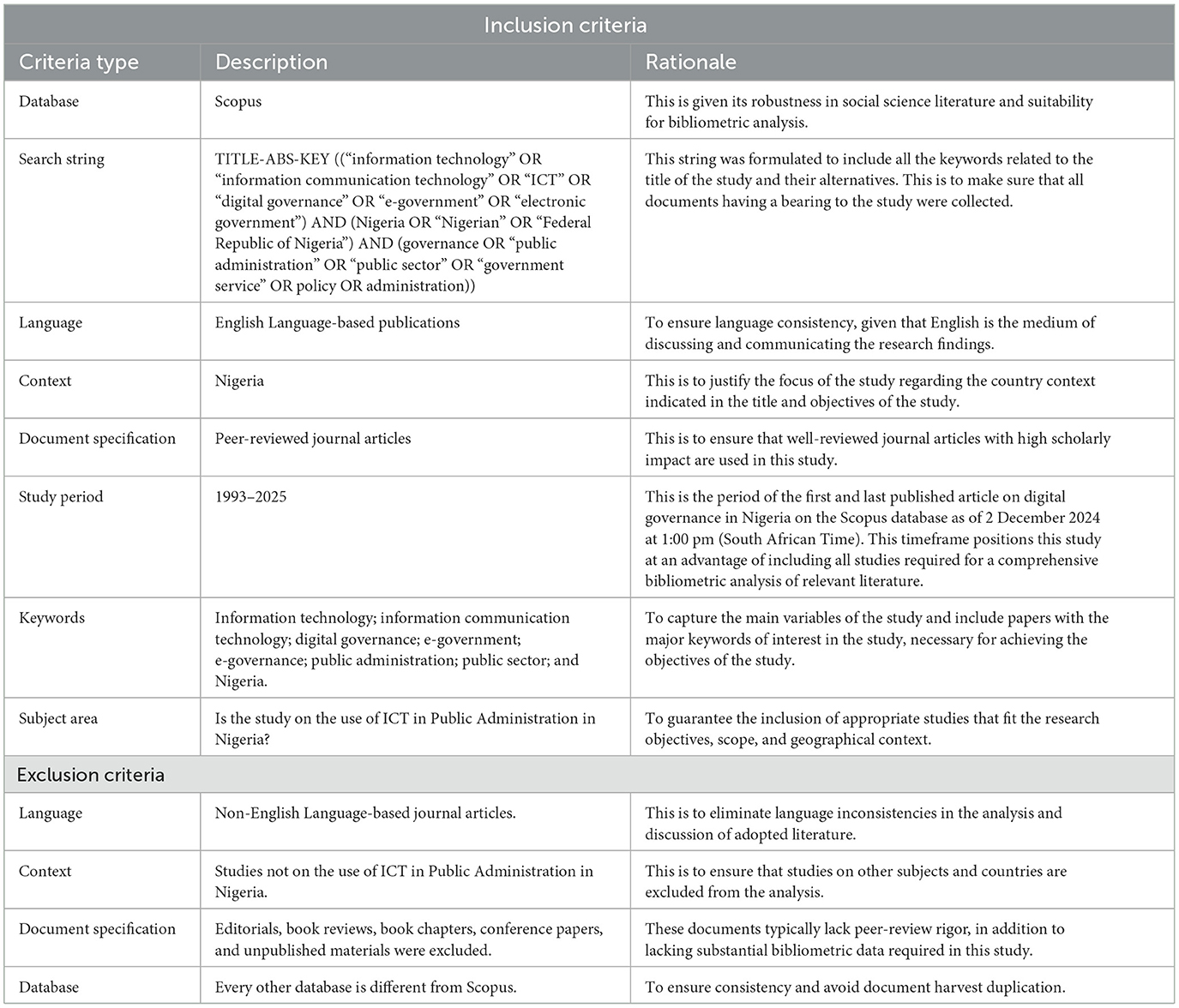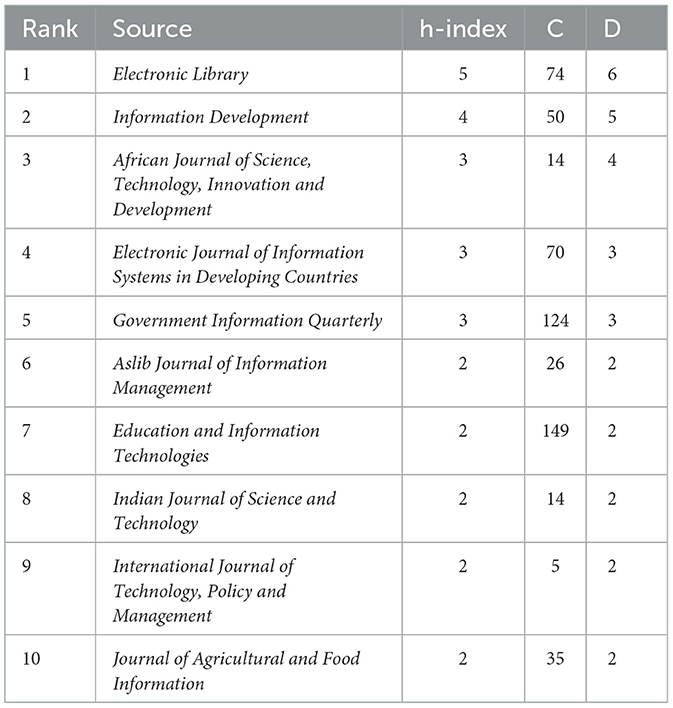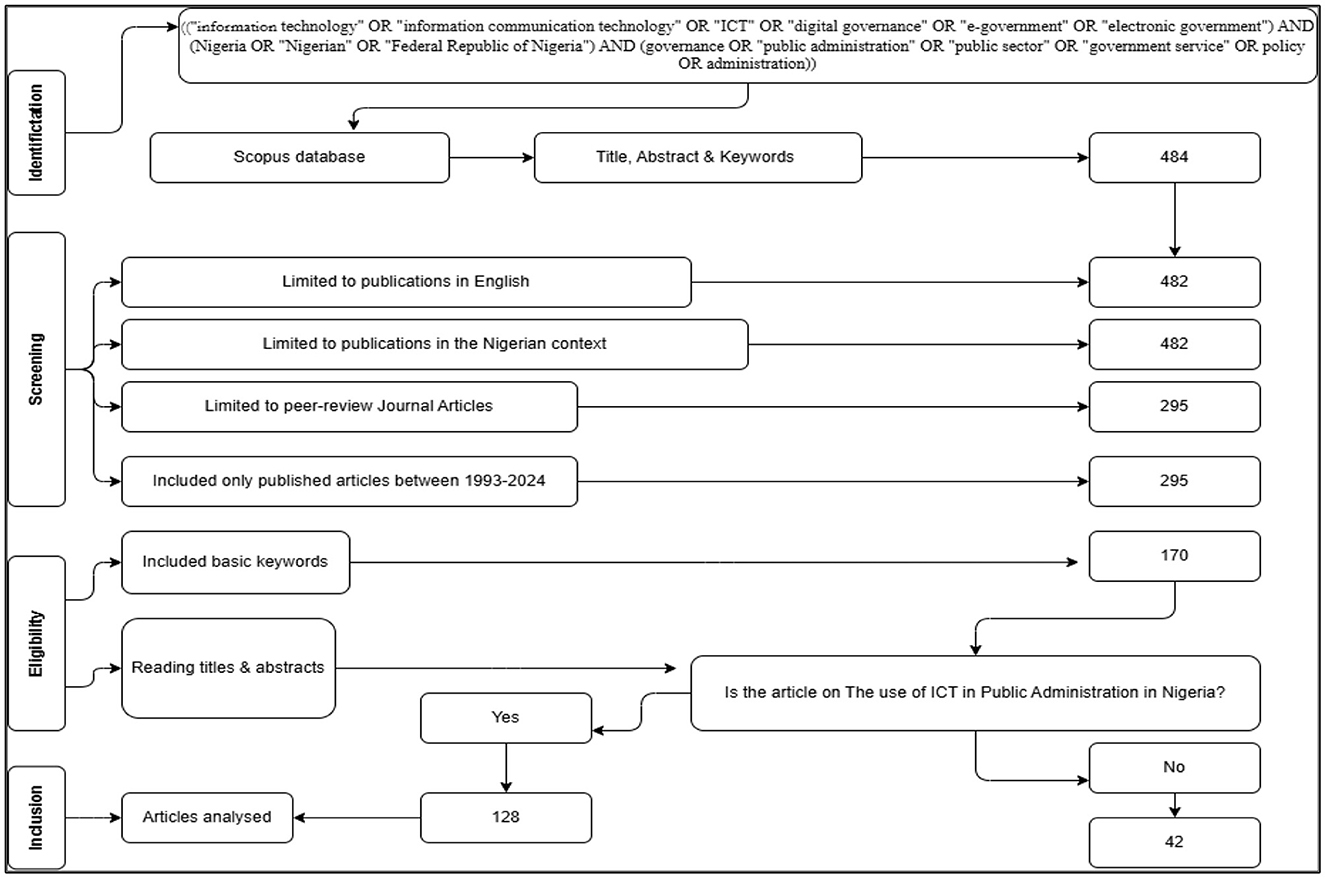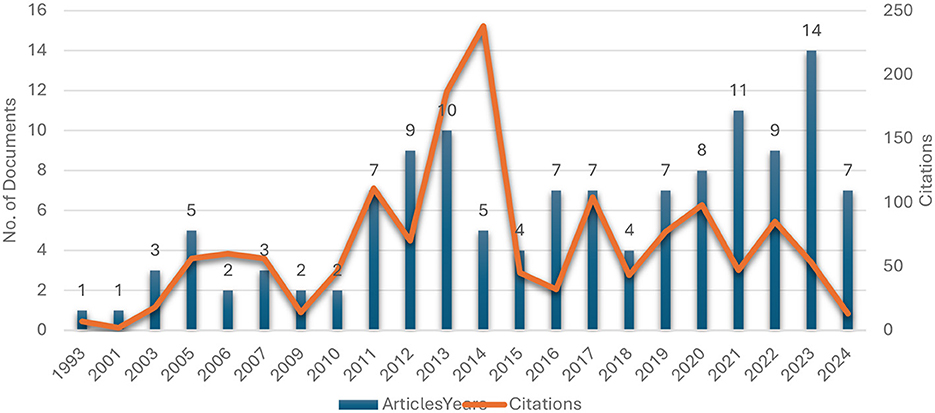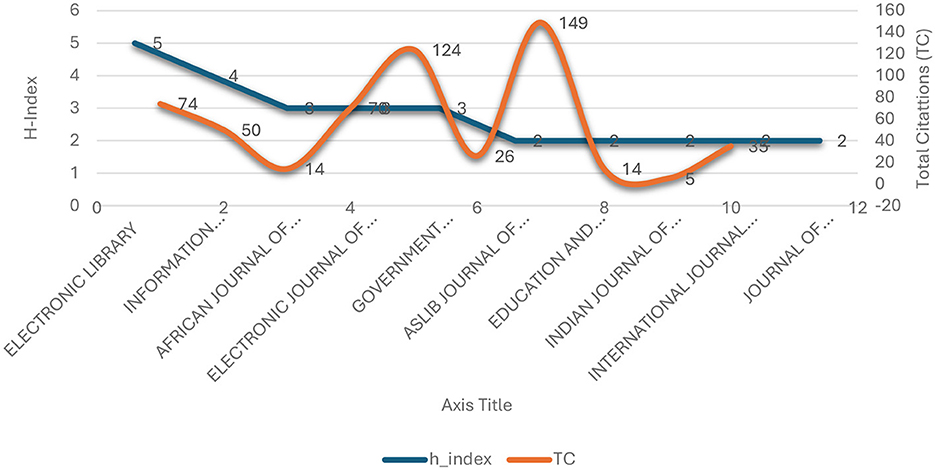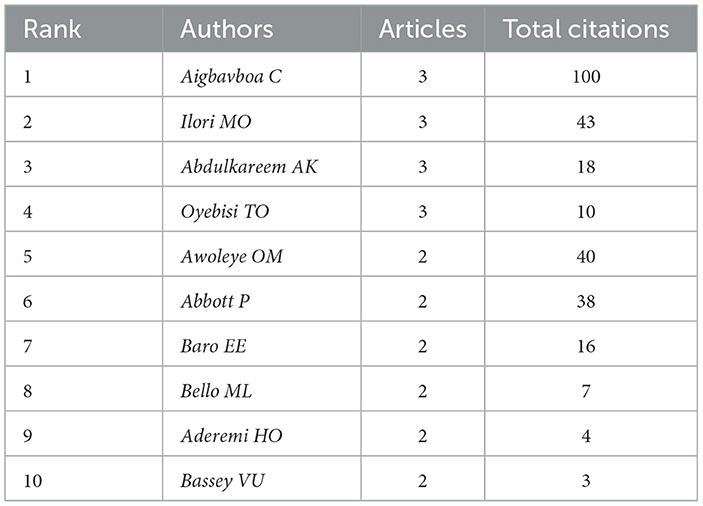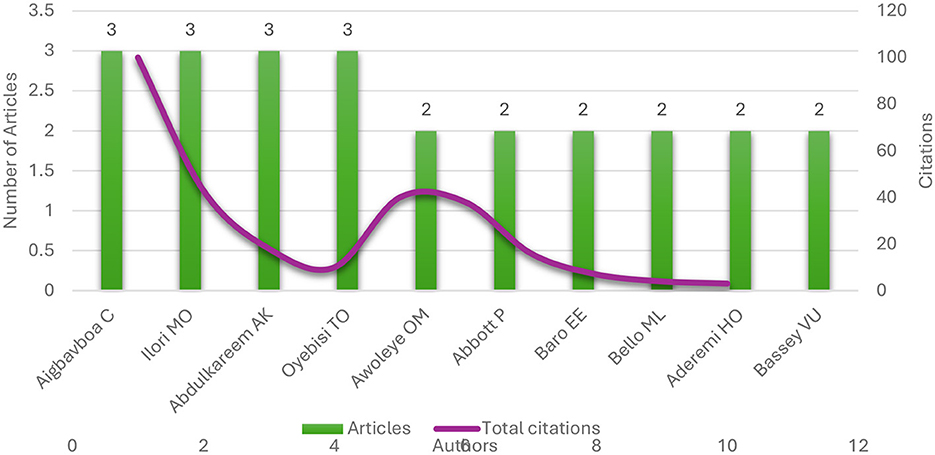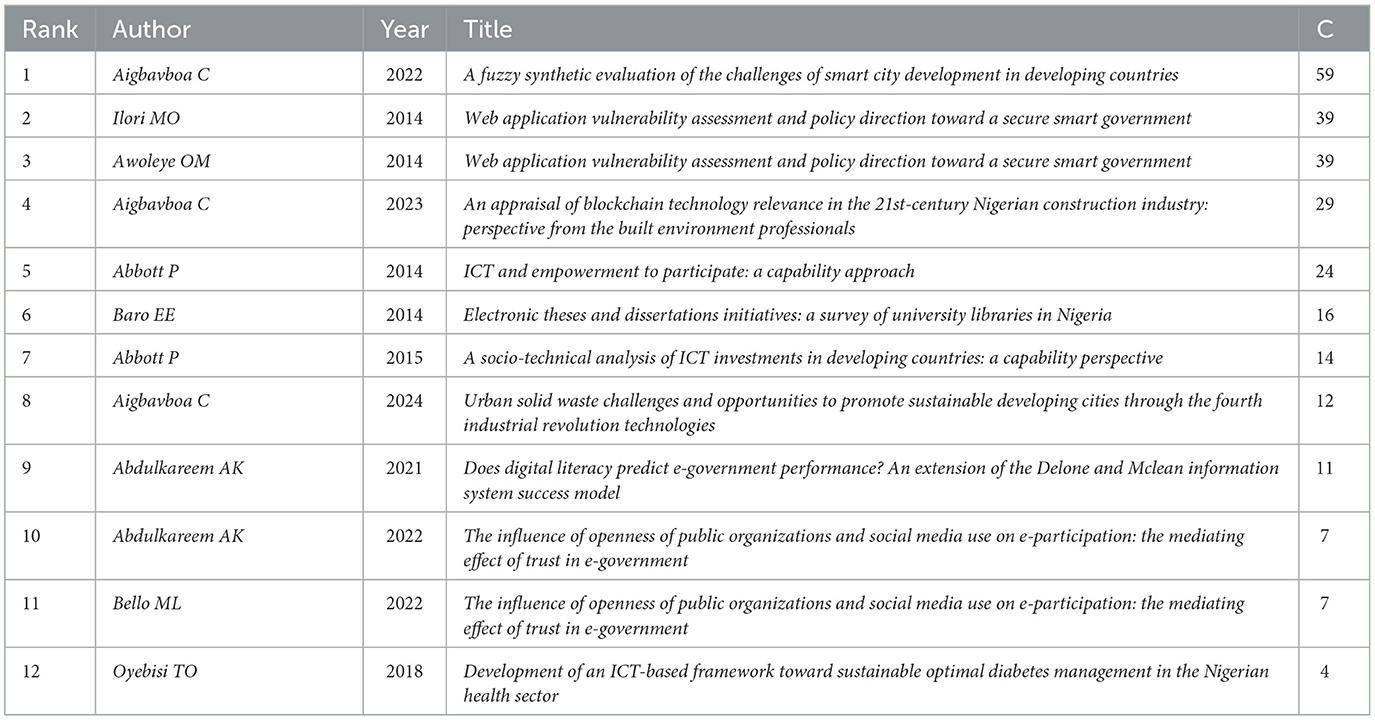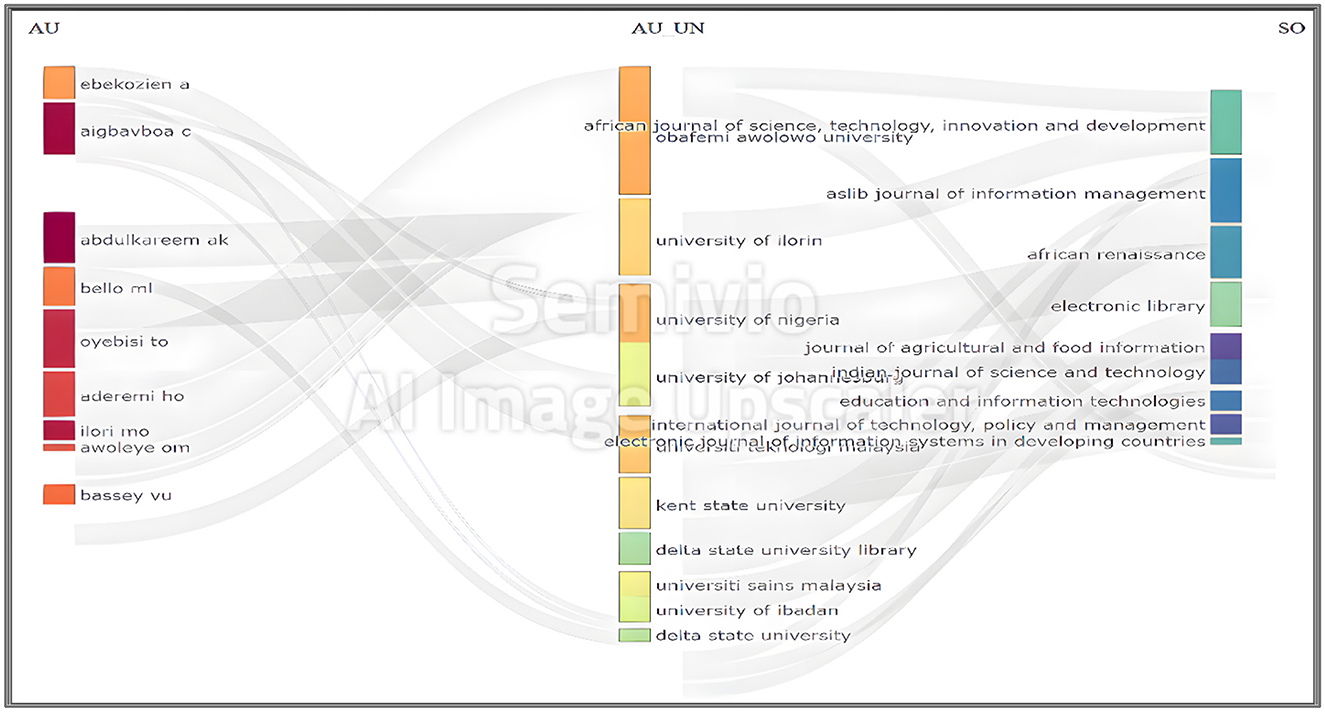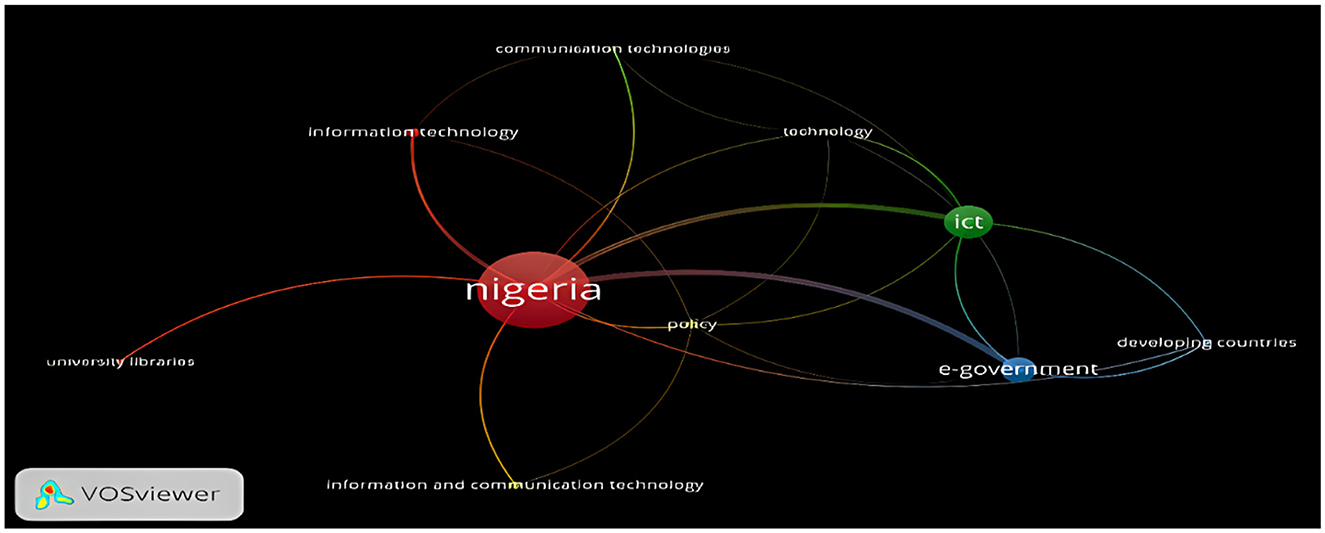- 1Department of Urban and Regional Planning, University of Johannesburg, Johannesburg, South Africa
- 2Department of Public Administration and Management, University of the Free State, Bloemfontein, South Africa
Introduction: The increasing adoption of technology by developing nations' governments has sparked academic interest in Nigeria, particularly regarding its role in public service delivery.
Methods: This study conducts a bibliometric analysis of 128 Scopus-indexed publications on Information and Communication Technology (ICT) in Nigerian public administration using VOSviewer and Biblioshiny tools.
Results: The analysis reveals that leading researchers from the University of Johannesburg, Obafemi Awolowo University, and the University of Ilorin dominate the field. Key publications appear in journals such as Electronic Library, Information Development, and Africa Journal of Science, Technology, Innovation and Development. Current research primarily focuses on e-governance adoption, implementation challenges, and success factors, with emerging interest in digital libraries, public value, and e-services.
Discussion: The study identifies critical research gaps, particularly in understanding digital governance's impact on vulnerable populations such as children, rural communities, the elderly, and people with disabilities. In addition, there is a need to develop context-appropriate indigenous technologies that incorporate emerging trends such as IoT, big data, and digital twins. The study recommends increased institutional support and funding for academic research to address these gaps and enhance the quality of ICT-public administration research in Nigeria.
1 Introduction
Meeting the demand of modern citizens is assuming a renewed complexity for governments, especially those in developing economies, given the dwindling national income and the rising cost of governance. In navigating this difficult terrain, these governments have subscribed to the application of Information and Communication Technologies (ICTs), otherwise called e-governance, in the delivery of public services (Adekoya et al., 2005; Adeyeye and Iweha, 2005; Asogwa, 2013). As succinctly captured by Dhamodharam and Saminathan (2011), e-governance refers to the application of information technologies in enhancing access to and delivery of public information and services to citizens, businesses, and government institutions. This digital service transformation, according to Abdulkareem et al. (2022a), is remodeling government activities, enhancing service delivery (Choudrie et al., 2017; Lawan et al., 2019; Olatubosun and Rao, 2012), while boosting citizens' satisfaction and trust in their governments (Amagoh, 2016; Okunola and Rowley, 2019). Furthermore, ICT is contributing significantly to designing smart cities (Aghimien et al., 2022; Ebekozien et al., 2024, 2023; Oladapo, 2006), improving good governance (Dhamodharam and Saminathan, 2011), accountability (Abdulkareem et al., 2022b; Ike et al., 2023), and information dissemination (Adomi et al., 2005), enhancing agricultural practices (Ajani and Agwu, 2012; Fawole and Olajide, 2012; Omekwu, 2003), and equally impacting job-related outcomes in the public sector (Abdulkareem et al., 2024) by presenting applicable technologies for enhancing job performance (Akwang, 2021; Ogbonna and Ebimobowei, 2013; Oyovwe-Tinuoye et al., 2021).
The first attempt toward the integration of ICT in public service delivery in Nigeria was observed in the early 2000s (Abdulkareem et al., 2022a; Abidogun, 2011; Adekoya et al., 2005; Amagoh, 2016; Hassan et al., 2011). Since then, progressive efforts have been observed (McGrath and Maiye, 2010), although not without occasional interruptions under different government administrations (Alakitan and Makinde, 2025). Over the years, this trend has caught the attention of researchers, who have continued to send out papers for publication on the use of ICT in public administration, but little is known about a systematic summary and analysis of new trends in this field. It is given this situation that the need for a comprehensive literature analysis arises. This will provide the platform for a proper understanding of areas that have been saturated and those starving of research attention. In coordinating existing studies on the subject to better guide future research efforts, this study conducted a bibliometric analysis of 128 papers published between 1993 and 2024 and indexed in Scopus. As Li et al. (2024) noted, bibliometric analysis is highly effective for mapping research trends and analyzing hotspots for future studies.
Furthermore, the choice of Scopus as the database for literature search in this study is predicated on several factors such as its robustness, peer-review rigor (Albugami et al., 2024; Pandita et al., 2023), multidisciplinarity (Kalia and Rajput, 2024), and its possession of bibliometric data necessary for conducting a bibliometric analysis (Aria and Cuccurullo, 2017). In addition, to avoid harvesting duplicated papers, many bibliometric analyses have stuck to a single database (Agyei et al., 2024; Pandita et al., 2023), rather than combining many.
In preparing a systematic summary and analysis of new trends in this field, this paper pursued the following objectives:
i. Identify the prolific authors on the use of ICT in public administration in Nigeria, their institutional affiliations, and journals.
ii. Analyse the dominant keywords within the research field of ICT use in the Nigerian public administration.
iii. Analyse and identify the dominant/emerging themes on the subject, and research gaps in the field of ICT use in the Nigerian public administration; and
iv. Provide policy recommendations for educational institutions and the government on how to support further studies in the research area.
These objectives, when achieved, will provide the platform for a proper understanding of the research area, such as the prolific authors, their collaboration network, publication outlets, as well as areas that have been saturated and those starving for research attention. Information on the authors, their affiliations, and journals will enable future research collaboration, mentorship, and idea exchange among researchers in this area. More importantly, out of the 128 papers harvested for this study, none was a bibliometric study of ICT-public administration-based research in Nigeria. This makes this paper one of the first of its kind and thus presents a valuable platform for guiding researchers on areas demanding attention on the subject.
2 Background on the use of information technologies in governance
The need for the integration of digital technologies in governance stemmed from the ineffectiveness and inefficiency of the traditional service delivery and governance systems (Adekoya et al., 2005; Lawan et al., 2019). These systems not only failed in meeting the contemporary needs of modern citizens, but they are also found wanting in minimizing governance cost, in the face of dwindling government revenue, especially among developing countries. Specifically in Nigeria, digital technology has been adopted in mitigating these challenges, while enabling the government to live up to the demands of its citizens. For instance, in enhancing election administration (Hassan et al., 2024; McGrath and Maiye, 2010; Uzodike and Onapajo, 2019), transforming public record management system (Abdulkareem et al., 2022b; Asogwa et al., 2021; Baro et al., 2014; Egoeze et al., 2018; Iwhiwhu, 2005; Kabir et al., 2017; Muhammad et al., 2020), public procurement (Musa et al., 2024), promoting accountability (Ike et al., 2023), trust and e-participation (Afieroho et al., 2023; Dasuki et al., 2014; Folorunso et al., 2012; Oni et al., 2020) through the use of social media (Abdulkareem et al., 2022a), and impacting job autonomy and satisfaction (Abdulkareem et al., 2024; Oyovwe-Tinuoye et al., 2021), the use of ICT is assuming prominence.
In addition, the role of ICT in the education sector, such as in research (Ani et al., 2015; Eze et al., 2013), teaching (Anemelu and Nwokolo, 2016; Elegbede et al., 2024; Ololube, 2013; Onasanya et al., 2010), especially at the pre-primary level (Abidogun, 2011; Jegede and Owolabi, 2003), in Computer-Based Testing (CBT) as notably adopted by the Joint Admission and Matriculation Board (JAMB; Abubakar and Adebayo, 2014), in library management (Aderibigbe and Ajiboye, 2013; Akwang, 2021; Augustine, 2021; Baro et al., 2014; Diyaolu and Oso, 2019; Friday and Eze, 2021; Imam and Ilori, 2023; Iwhiwhu and Eyekpegha, 2009; Iwhiwhu, 2005; Kelvin et al., 2012; Oberhiri-Orumah and Baro, 2023), and the manufacturing sector (Buba et al., 2022), cannot be undermined. Furthermore, ICT tools are an indispensable component of an efficient and effective electricity supply (Dasuki and Abbott, 2015; Dasuki et al., 2014) and healthcare service delivery (Baridam and Govender, 2016; Gyebo et al., 2022; Ikwu et al., 2021; Kabir et al., 2017; Obasola and Mabawonku, 2017; Yuan et al., 2021). For instance, in the management of chronic diseases such as heart disease, cancer, and diabetes, Health Information Technology (HIT) applications have offered succor given the need for effective information management in managing patients with these cases (Ayanlade et al., 2018). Furthermore, Kabir et al. (2017) examined the factors that influence the behavioral intentions of medical employees in the Nigerian federal hospitals toward the e-collection system. Their study identified Perceived Usefulness, Perceived Ease of Use, and Computer Self-efficacy as the determining factors and thus recommended that these factors be put into consideration when planning and designing electronic government initiatives in the country. In pursuit of a similar objective but on the part of the citizens, Muhammad and Kaya (2023) identified performance expectancy and effort expectancy as the major determinants of citizens' attitudes toward e-government in Nigeria.
The use of ICT in these areas indicated the general level of acceptance received by technology in Nigeria (Lawan et al., 2019). Despite this digital enthusiasm, however, research on the subject has remained uncoordinated. With this trend, proper coordination of valuable research effort required for advancing knowledge in this area is lacking, thereby leaving areas such as the relevance of AI, IoT, digital twins (Alakitan and Makinde, 2025), and smart city initiatives implementation in Nigeria (Aghimien et al., 2022) that is critical to both citizens and the environment, unattended. It is in addressing this lacuna that this study assumes relevance.
3 Research methodology
In pursuit of the objectives of this study, a comprehensive bibliometric analysis using relevant literature adopted from the Scopus database was conducted. This process involved several activities such as literature search, screening, analysis, and discussion. VOSviewer and Biblioshiny were the basic analytical tools used, while tables, figures, and charts were adopted for data presentation in this study. Like previous papers on bibliometric analyses, such as those of Agyei et al. (2024), Albugami et al. (2024), Ozen Cinar (2024), Mufungizi et al. (2023), Muzioreva et al. (2022), and Pandita et al. (2023), this study leveraged the Preferred Reporting Items for Systematic Review and Meta-Analysis (PRISMA) items for literature inclusion and exclusion.
Even though there are varied methods for conducting a literature review, such as Systematic Literature Review (SLR), Narrative Review, Meta-Analysis, and Content Analysis, bibliometric analysis offers additional opportunities for engaging literature more critically. For instance, while SLR engages literature comprehensively using a predefined protocol with explicit inclusion and exclusion criteria, it cannot visualize the relationship between publications. In addition, a narrative review provides an in-depth conceptual understanding of research based on the author's expertise and selection but poses high potential for literature selection bias, and equally, with a limited chance for reproducibility. In addition, for meta-analysis, even though it is effective for synthesizing quantitative findings from multiple studies, it cannot link heterogeneous quantitative studies. Finally, content analysis has assumed prominence in the systematic coding and analysis of textual content; however, it is insufficient in effectively mapping the research landscape.
Despite that, bibliometric analysis is not perfect in its approach, yet it provides quantitative metrics for reproducibility and enhancing scientific rigor. Furthermore, it uniquely allows for the visualization of the interconnections among literature, such as co-citation analysis and bibliometric coupling.
3.1 Data collection
Data collection revolves around the processes observed in gathering literature for this study. This study relied on peer-reviewed articles from the Scopus database. The choice of this database was based on many considerations. At first, Scopus is a robust warehouse for quality articles, given the review rigor of journals indexed in the database (Albugami et al., 2024; Pandita et al., 2023). Second, it is one of the largest and most robust databases for social science literature (Kalia and Rajput, 2024). Finally, Aria and Cuccurullo (2017) identified Scopus as one of the databases with appropriate bibliometric data required for an ideal bibliometric analysis. In addition, to avoid harvesting duplicated papers, many bibliometric analyses have stuck to a single database (Agyei et al., 2024; Mufungizi et al., 2023; Pandita et al., 2023).
In the search for contemporary literature from the Scopus database, a search string (see Table 1) was formulated from the relevant keywords of “information technology,” “information communication technology,” “digital governance,” “e-government,” “e-governance,” “public administration,” “public sector” and “Nigeria.”
Using the criteria in Table 1, and as common in previous bibliometric studies (Agyei et al., 2024; Li et al., 2024; Pandita et al., 2023), this study conducted a comprehensive literature search on 2 December 2024 at 1:00 pm, where 484 kinds of related literatures were found in the Scopus database, and in streamlining this, selected inclusion and exclusion criteria from the 27-item as contained in the PRISMA 2020 checklist were adopted (see Table 2, Figure 1). In scaling down the collated documents, therefore, the parameter of English Language (482), in the Nigerian context (482), peer-reviewed journal articles (295), study period (295), keywords (170), and the comprehensive research context (128) were adopted. Finally, the exclusion criteria observed in this study were non-English Language written articles, studies not on the Nigerian context, documents without peer-reviewed rigor, and those not indexed in Scopus.
3.2 Research design
In pursuit of the objectives of this paper, a bibliometric analysis was conducted. A bibliometric analysis is a quantitative method used to evaluate and analyse academic literature (Aria and Cuccurullo, 2017; Kalaoane et al., 2024; Li et al., 2024; Ozen Cinar, 2024; Pandita et al., 2023) to ascertain the main features of the literature. These features include the prolific authors, their citations, affiliations, co-occurrence, social networks, etc. Unlike a systematic literature review, this analysis provides more objective and reliable literature analysis (Aria and Cuccurullo, 2017; Kalia and Rajput, 2024). In addition, this analysis has assumed popularity among scholars in exploring the research trend and gap in specific research areas (Agyei et al., 2024; Albugami et al., 2024; Aria and Cuccurullo, 2017; He et al., 2025; Kalaoane et al., 2024), even though Mufungizi et al. (2023) argued that there is a need to support this analysis with a literature content analysis. In accommodating this suggestion, this study included a content analysis of the adopted papers.
In the conduct of this study, VOSviewer, an open-sourced web interface (Van Eck and Waltman, 2023), and biblioshiny, a component of R tool for bibliometric analysis (Aria and Cuccurullo, 2017; Ozen Cinar, 2024; Pandita et al., 2023), were adopted for engaging in a comprehensive analysis of the adopted 128 documents. Several bibliometric studies, such as Albugami et al. (2024) and Pandita et al. (2023), have leveraged these tools for achieving their objectives. As noted in the study of Pandita et al. (2023), and as emulated in this study, citation and document analyses were observed using biblioshiny, where the annual document production and citations were presented. Furthermore, the leading journals in digital governance research in Nigeria were identified with their respective h-index, annual document production, and citations. Unlike most bibliometric analyses, this study incorporated the h-index as a parameter for ascertaining leading journals in the field of ICT use in governance.
In pursuit of the first objective of the study, distinct parameters such as prolific authors with the highest annual research output and citations were considered. In addition, their institutional affiliations were identified. Moreover, the top 10 articles with the highest citations were presented. Furthermore, in linking authors to their respective affiliations and sources, a three-field plot was prepared. This was followed by a word cloud indicating the dominant keywords in the adopted papers. Finally, a keyword co-occurrence network using VOSviewer (Van Eck and Waltman, 2023) and a thematic mapping of adopted literature using biblioshiny were prepared. These allowed for a discussion of the research themes in existing literature, which then allows for the identification of research gaps requiring scholarly attention (Agyei et al., 2024; He et al., 2025; Kalaoane et al., 2024; Kalia and Rajput, 2024).
4 Results
Following the stated procedures, the analysis of the adopted documents is sequentially presented in the order of document analysis; document annual production and citations; prominent sources; prolific authors and their affiliations; word cloud; keyword co-occurrence network; and thematic mapping.
4.1 Document report
As equally adopted by Agyei et al. (2024), Ozen Cinar (2024), and Pandita et al. (2023), this study first presented a succinct summary of the documents adopted in the study. In Figure 2, a total of 128 documents published between 1993 and 2025 in 96 Scopus-index publication outlets were adopted. The annual research growth in digital governance in Nigeria was 6.48%. This indicated a significant increase in the annual document production in the research area. Furthermore, a total of 368 authors produced the 128 documents, where 27 single-authored documents were found. The rate of co-authors per document was calculated to be 3.09, while international co-authorship was calculated to be 21.09%. These indicated the presence of robust national and international research collaborations among scholars in the research area.

Figure 2. Document report. Source: Biblioshiny/Bibliometrix output (Aria and Cuccurullo, 2017).
More particularly, this collaboration equally cuts across disciplines and fields, showing multidisciplinarity and cross-border research collaboration as presented in Section 4.4. Finally, the report showed that in the adopted documents, there were 446 keywords, 5,662 references, and 11.42 average citations per documents.
4.2 Document and citation analyses
In Figure 3, the annual document production and citations of adopted literature were presented. In the analysis, the highest number of documents were recorded in 2011 (7); 2012 (9); 2013 (10); 2016, 2017, 2019 (7); 2020 (8); 2021 (11); 2022 (9); 2023 (14); and 2024 (7). In justifying the study period of 1993–2025 adopted in this study, Agunloye (2007) and Adeyeye and Iweha (2005) posited that the earliest move toward the integration of ICT in the Nigerian governance system can be traced to the establishment of the Nigerian Communication Commission (NCC) in 1992. It is from this background that the first published paper on the use of ICT in the Nigerian public sector was published the following year, in 1993. Between 2000 and this year, no publication on the subject was recorded until the NCC was rejuvenated in 2000 (Agunloye, 2007), the National Information Technology Policy in March 2001 (Baridam and Govender, 2016; Hassan et al., 2011; Martens et al., 2020), while the National Information Technology Development Agency (NITDA) was established in 2001 (Adeyeye and Iweha, 2005; Awoleye et al., 2014; Eke, 2011). This resulted in a renewed attempt at integrating ICT in public service delivery in Nigeria (Abdulkareem et al., 2022a). After this renewed effort, another publication was recorded in 2001, and from then on, the subject has continued to experience an increase in scholarly attention. This confirms the nexus between theory (research) and practice.
In addition, in 2013, the National Service Portal, a web-based platform offering interconnectedness among government Ministries, Departments, and Agencies (MDAs), was launched (Asogwa, 2013). This move signaled the enhancement of the electronic public service (e-public service) delivery mechanism in Nigeria. This giant stride could explain the increase in scholarly production on the use of ICT in governance in Nigeria from 2011 to 2024. Since 2013, successive government administrations in Nigeria have continued to intensify efforts to advance e-public service delivery (Alakitan and Makinde, 2025).
Regarding document citations, the nine highest citations were recorded in 2006 (60), 2011 (111), 2012 (70), 2013 (187), 2014 (238), 2017 (104), 2019 (77), 2020 (98), and 2022 (85). Unlike the annual document production, explaining the document citation trend has some complexity to it. At first, there was a steady rise in the number of citations from 2001 to 2007, after which there was a sharp drop from 56 to 14 citations. This could indicate a shift in research focus on the subject, occasioned by the prolonged decline in government attention toward the digitisation of government process and procedure, at least until the launch of the national service portal in 2013, after which the two highest numbers of citations were recorded. In essence, there appears to be a link between the development of ICT in governance and research production among scholars, and this affects the number of citations, as well.
4.3 Ten prominent sources with the highest h-index, number of documents, and citations
Table 2 and Figure 4 present the 10 prominent literature sources on the use of ICT in governance in Nigeria. These sources were identified using three basic criteria of h-index, citations, and number of documents. The h-index (or Hirsch index) is a metric used primarily in academic and scientific research to measure both the productivity and citation impact of a researcher's publications. As presented in the table below, Electronic Library, a Q2 journal (as of 2023) published by Emerald Insight, recorded the highest h-index of 5 and the highest number of documents. This journal dates to 1983 and had its first issue focusing on the use of digital tools for enhancing library management. Consequently, the journal has continued to publish quality articles on the use of information technology for service delivery. In addition, the 6 documents published in the journal recorded 74 citations, showing that the journal is well acknowledged in the literature.
Information Development is another prominent source among those adopted in this study. The journal recorded an h-index of 4, 5 documents, and 50 citations. This journal, with a focus on library and information science, is published by SAGE Publications Limited and has been in existence since 1985. Other sources had an h-index of between 3 and 2 and with documents ranging between 4 and 2. In terms of citations, Education and Information Technologies had 149 citations with just 2 documents. Following this feat is Government Information Quarterly with 124 citations and 3 documents.
Other sources with an impressive number of citations are Electronic Journal of Information Systems in Developing Countries (70) and Journal of Agricultural and Food Information (35). Each of the sources adopted in this study and as captured in Figure 4 represents a significant player in the publication of high-quality manuscripts in the field of information technologies, not just in Nigeria, but across the world. This is evident in the spread of their authors across prominent institutions and countries.
4.4 Ten most prolific authors
In the focused subject area of ICT use in Nigeria's Public Administration research, the prolific authors are as shown in Table 3 and Figure 5. In the ranking of these authors, their respective numbers of articles and citations were adopted. This allows for the consideration of both the quantity and quality of authors' research output. First on this list is Aigbavboa C with 3 articles and 100 citations (Aghimien et al., 2022; Ebekozien et al., 2024, 2023). Other authors with 3 articles but with varied citations were Ilori MO (43) (Adelowo et al., 2023; Awoleye et al., 2014; Sanni et al., 2001), Abdulkareem AK (18) (Abdulkareem et al., 2022a, 2024; Abdulkareem and Ramli, 2021), and Oyebisi TO (10) (Ajao et al., 2018; Ayanlade et al., 2018; Hassan et al., 2011). These authors have demonstrated consistency in producing quality research focusing on the use of ICT in Nigeria's Public Administration.
Concerted research effort toward the subject of ICT use in the Nigerian public administration has also been demonstrated by Awoleye OM (Awoleye, 2022; Awoleye et al., 2014), Abbott P (Dasuki and Abbott, 2015; Dasuki et al., 2014), Baro EE (Baro et al., 2014; Oberhiri-Orumah and Baro, 2023), Bello ML (Abdulkareem et al., 2022a, 2024), Aderemi HO (Aderemi et al., 2015; Ajao et al., 2018), and Bassey VU (Ike et al., 2023; Inakefe et al., 2023) with 2 published articles each and 40, 38, 16, 7, 4, and 3 citations, respectively. These authors, as complementarily presented in Figure 5, represent the body of scholars with consistent research effort on this study. However, there is evidence of significant collaborative work among these authors as presented in Figure 6. In the figure were 11 clusters indicating the various groups of authors that have worked together. The extent of their collaboration is showcased with the thickness of their connecting lines (Van Eck and Waltman, 2023).
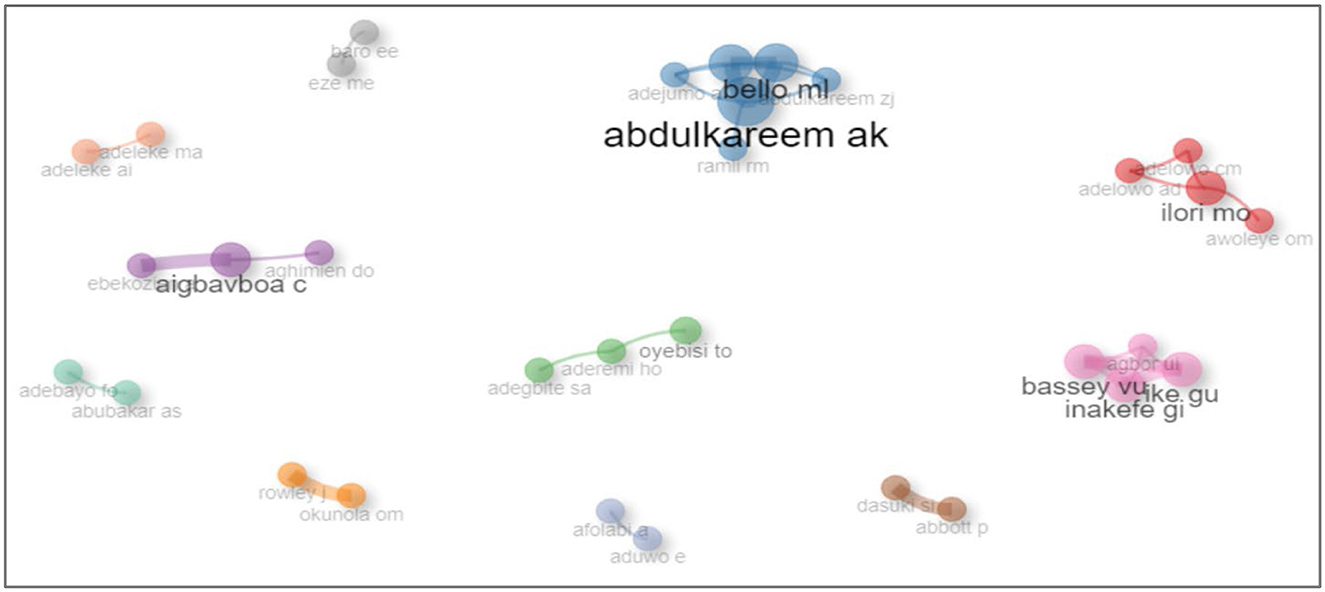
Figure 6. Co-authorship network. Source: Biblioshiny/Bibliometrix output (Aria and Cuccurullo, 2017).
For instance, Aigbavboa, Ilori, and Abdulkareem, the top three authors with the highest number of articles, have collaborated with other authors such as Awoleye, Adelowo AD, Adelowo CM, Bello, Ishola, Ramli, Abdulkareem ZJ, Adejumo, Oyebisi, Aderemi, Adegbite Ebekozien, and Aghimien. An analysis of the three clusters comprising these authors indicated that their studies have centered on the challenges confronting ICT hubs in Nigeria (Adelowo et al., 2023) and those of smart city development in developing countries (Aghimien et al., 2022; Ebekozien et al., 2024, 2023); the role of digital literacy in predicting e-government performance (Abdulkareem and Ramli, 2021; Inakefe et al., 2023); the influence of openness of public organizations and social media use on e-participation and the mediating effect of trust in e-government (Abdulkareem et al., 2022a); and the impact of ICT adoption on job-related outcomes in the Nigerian public sector (Abdulkareem et al., 2024).
In understanding the underlying factors prompting these collaborations, this paper presented a three-field plot as shown in Figure 7. In the figure, Abdulkareem has dual affiliation with the University of Ilorin, where he collaborated with Bello and Ishola (Abdulkareem et al., 2022a, 2024), and Universiti Sains Malaysia, where he wrote an article with Ramli (Abdulkareem and Ramli, 2021). Equally, Ilori, Awoleye, Oyebisi, Adelowo AD, Adelowo CM, and Aderemi are all sharing Obafemi Awolowo University as their primary institutional affiliation (Adelowo et al., 2023; Aderemi et al., 2015; Awoleye, 2022; Awoleye et al., 2014; Hassan et al., 2011). Similarly, Aigbavboa, Ebekozien, and Aghimien have shared affiliation with the University of Johannesburg, South Africa (Aghimien et al., 2022; Ebekozien et al., 2024, 2023).
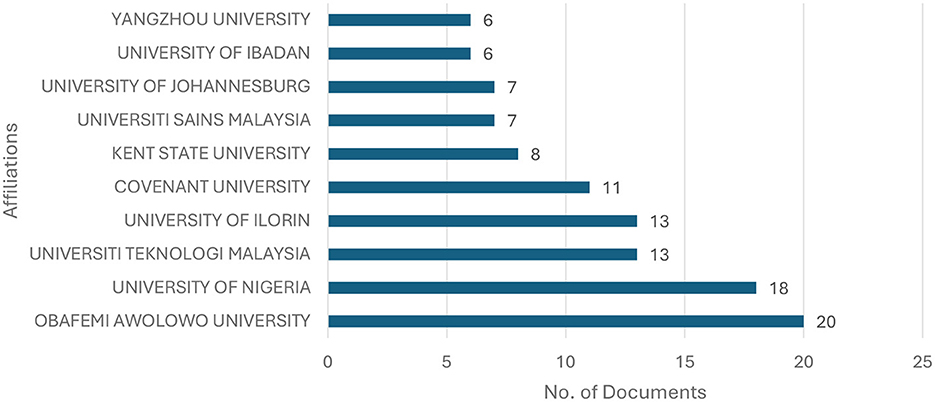
Figure 7. Authors' affiliation and sources link. Source: Biblioshiny/Bibliometrix output (Aria and Cuccurullo, 2017).
In support of Table 3 and Figure 5, above, Table 4 shows the list of the top 10 articles with the highest citations about this study. Just as indicated earlier, Aigbavboa C and Ilori MO topped the list with their papers published in 2022 and 2014, respectively. The study on a fuzzy synthetic evaluation of the challenges of smart city development in developing countries by Aigbavboa C examined the challenges confronting the proper domestication of smart city initiatives among developing countries. It found that issues relating to environmental, technological, social, and legal factors are the major challenges confronting the effective implementation of smart city projects in developing countries. The significance and impact of the findings can be observed in the number of citations it garnered within just 3 years. In addition, Ilori MO's study on Web application vulnerability assessment and policy direction toward a secure smart government produced outstanding recommendations for mitigating web application vulnerability (Awoleye et al., 2014).
Other studies on the list with impressive citations were produced by Awoleye OM (Awoleye, 2022; Awoleye et al., 2014); Aigbavboa C (Aghimien et al., 2022; Ebekozien et al., 2024, 2023); Abbott P (Dasuki and Abbott, 2015; Dasuki et al., 2014); Baro EE; Abdulkareem AK (Abdulkareem et al., 2022a; Abdulkareem and Ramli, 2021); Bello ML (Abdulkareem et al., 2022a); and Oyebisi TO (Ayanlade et al., 2018). Each of these studies explored varied aspects of smart governance models. For instance, Abdulkareem and Bello examined the influence of social media use by government agencies as a motivator for public participation and public trust building in Nigeria (Abdulkareem et al., 2022a); Abdulkareem and Ramli examined the predictive role of digital literacy on e-government performance in Nigeria (Abdulkareem and Ramli, 2021; Okunola et al., 2017). Oyebisi, in a collaborative study with Ayanlade and Kolawole, established the continued investment in Health Information Technology (HIT) applications for managing chronic diseases such as diabetes (Ayanlade et al., 2018).
4.5 The most relevant affiliations
Out of the 128 documents adopted in this study, 109 were from 10 universities across the world, with half of them from Nigeria. These data positioned Nigerian universities as the highest producers of research papers on the use of ICT in public administration in the country, a strong indication of growing interest in the use of ICT for governance among home-based Nigerian scholars. As captured in Figure 8 below, 20 research articles were from authors with an affiliation in Obafemi Awolowo University, Ile-Ife, Osun, Nigeria. This university, established in 1961, has remained an ambitious institution of learning with high research output. Following in this trend were the University of Nigeria, Nsukka, Anambra State, Nigeria (18 articles); Universiti Teknologi Malaysia, Johor Bahru (13 articles); University of Ilorin, Ilorin, Nigeria (13 articles); and Covenant University, Sango-Otta, Ogun State, Nigeria (11 articles).
Other universities with a high number of published articles about this study were Kent State University, Ohio, US; Universiti Sains Malaysia, George Town, Malaysia; University of Johannesburg, Johannesburg, South Africa; University of Ibadan, Ibadan, Nigeria; and Yangzhou University, Yangzhou, China.
Continuing from Figure 8 above, it can be seen from Figure 7 that a linkage was provided showing the authors, their sources, and affiliations. This figure complements the information provided on each of these parameters. For instance, Aigbavboa C, a prolific author on the use of ICT in the Nigerian public administration, has at different times secured affiliation with the University of Johannesburg (Aghimien et al., 2022; Ebekozien et al., 2024, 2023) and the University of Ibadan, while his studies were published in Aslib Journal of Information Management, Smart and Sustainable Built Environment, and the International Journal of Building Pathology and Adaptation. Equally, Abdulkareem AK, another prolific author with three papers has dual affiliation with University of Ilorin, where he lectures and Universiti Sains Malaysia, where he earned his Ph.D. in 2022, has published with International Review of Public Administration, a publication by Routledge, Taylor & Francis Group (Abdulkareem et al., 2022a); Journal of Information, Communication and Ethics in Society, published by Emerald Publishing Limited (Abdulkareem et al., 2024) and Electronic Government, by Inderscience Publishers (Abdulkareem and Ramli, 2021). This figure presents readers with the opportunity to trace authors to their respective affiliations and journal sources.
4.6 Thematic analysis
Aside from the basic quantitative analysis of the adopted documents, this section examined the thematic analysis of the studies in a bid to explain their specific research focus, despite their concentration on the use of ICT in the Nigerian public administration. To do this, the word cloud is first presented to explore the prominent authors' keywords in the adopted studies. In addition, a co-occurrence network of the keywords was presented as a parameter for article categorization (Agyei et al., 2024). Finally, the thematic map of these keywords was presented to group the adopted studies into motor, niche, basic, and emerging or declining themes. This will expose the various areas of research concentration, as well as areas requiring further research attention.
In Figure 9, Nigeria, with 70 occurrences, 9 links, and a total link strength of 52, was the most common keyword used in the 128 papers analyzed in this study. This indicated the significance of this keyword to this study. Furthermore, it reflects the environmental context of the studies, which confirms the appropriateness of the adopted papers. In addition, ICT and e-government assumed prominence among the adopted keywords. This is given their link with the subject of the investigation. Other popular keywords found in the adopted papers were information technology, developing countries, communication technologies, policy, and information and communication technology.
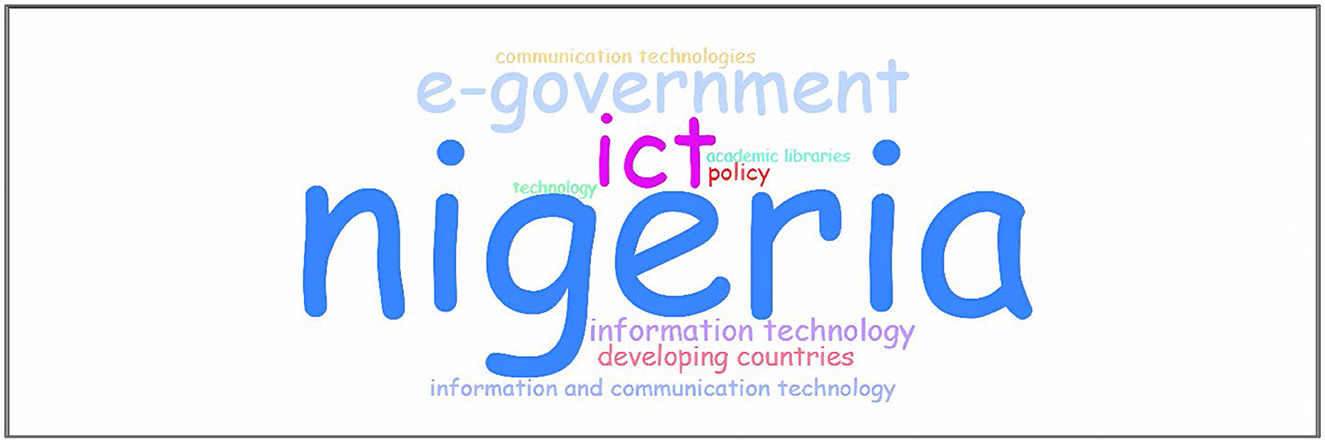
Figure 9. Ten most common authors' keywords. Source: Biblioshiny/Bibliometrix output (Aria and Cuccurullo, 2017).
In establishing the keyword co-occurrence network for this study, VOSviewer was employed. This software is effective for preparing keyword co-occurrence networks (Kalia and Rajput, 2024; Van Eck and Waltman, 2023), as illustrated in Figures 10, 11. To ensure a substantial number of authors' keywords were captured, this study adopted a minimum threshold of 5 occurrences. As indicated in the literature, studies with a larger number of authors' keywords can use a higher benchmark of around 10 occurrences (Pandita et al., 2023) to reduce the complexity of the generated network. The three most prominent authors' keywords in the network were Nigeria, ICT, and e-government. The prominence of these keywords reflects their significance to the objectives of the study and to identifying relevant literature. For instance, Nigeria, with 70 occurrences and a total link strength of 52, is connected to 9 other items in the network, highlighting the centrality of this keyword to the study. Similarly, ICT, linked to 6 items, has 30 occurrences and a total link strength of 23, while e-government, connected to 5 items, has a total link strength of 21 and 23 occurrences. Both keywords played crucial roles in selecting papers for this study. In concluding this analysis, there appears to be a relationship among these three keywords as they recorded more total strength links than all others combined. This could be due to their centrality to the paper's title and the fact that achieving e-government in Nigeria relies on the application of ICT (Abdulkareem and Ramli, 2021; Adekoya et al., 2005).
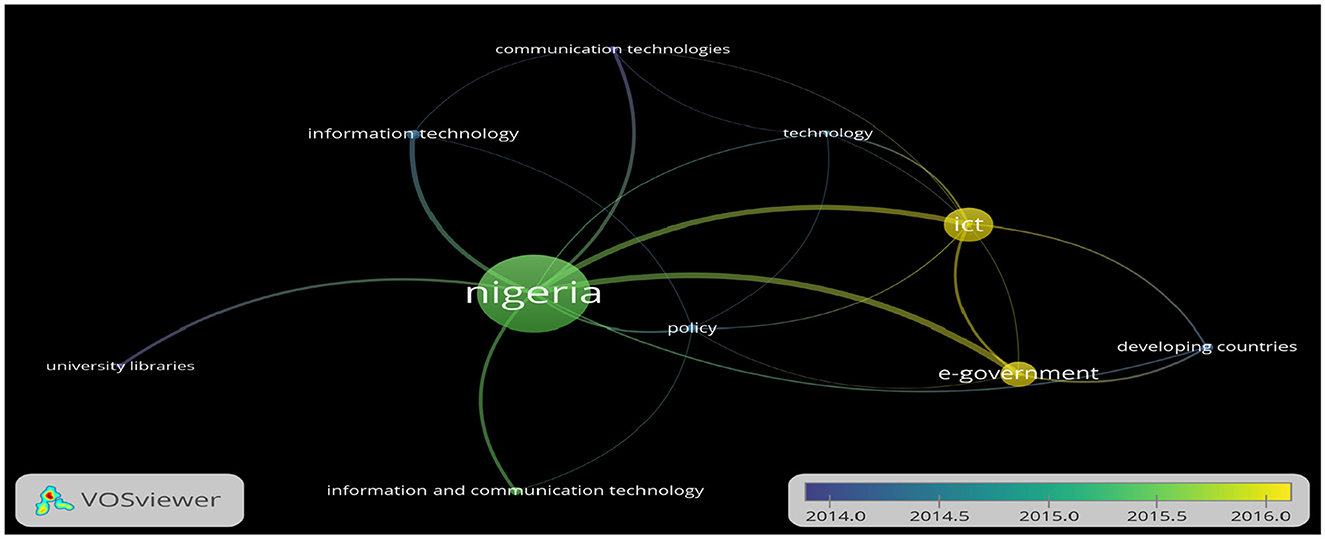
Figure 11. Authors' keyword co-occurrence network (overlay visualization). Source: VOSviewer output.
In Figure 10, as well, the nodes are clustered into four colors of red, green, blue, and yellow. The size and lines connecting the nodes also speak to the relationship among the nodes. While the size of the nodes denotes the number of occurrences (Mufungizi et al., 2023; Van Eck and Waltman, 2023), distance indicates the relatedness of items, and the thickness represents the strength in the relationship among items (He et al., 2025; Van Eck and Waltman, 2023). In the first cluster, denoted in red, 3 keywords of “information technology, Nigeria, and university libraries” can be found. This cluster portrayed ICT research trend in Nigeria, which is prominent in the deployment of information technology in the university system, such as in teaching (Abidogun, 2011; Elegbede et al., 2024; Jegede and Owolabi, 2003; Ololube, 2013; Onasanya et al., 2010), research (Ani et al., 2015; Eze et al., 2013; Ololube et al., 2013), conduct of examination (Abubakar and Adebayo, 2014), management of academic libraries (Aderibigbe and Ajiboye, 2013; Akwang, 2021; Ani et al., 2015; Anyira, 2013; Asogwa et al., 2021; Augustine, 2021; Baro et al., 2014; Diyaolu and Oso, 2019; Friday and Eze, 2021; Imam and Ilori, 2023; Iwhiwhu and Eyekpegha, 2009; Iwhiwhu, 2005; Kelvin et al., 2012; Oberhiri-Orumah and Baro, 2023), and record management (Abdulkareem et al., 2022b; Egoeze et al., 2018). This showed that most studies adopted in this study investigated the extent of ICT use in the Nigerian education and public service delivery sector (Abdulkareem et al., 2022b; Abidogun, 2011; Abubakar and Adebayo, 2014; Aderibigbe and Ajiboye, 2013; Muhammad et al., 2020). However, the link strength and relatedness between Nigeria and information technology is stronger than that of Nigeria and university libraries.
In the second cluster, denoted in green, keywords such as “communication technology, ICT, and technology” can be observed. This cluster combined elements of e-governance efforts in Nigeria and the need for investment in technology adoption (Adekoya et al., 2005; Adelowo et al., 2023; Akwang, 2021; Dhamodharam and Saminathan, 2011; Oladipo et al., 2016). In this regard, for instance, Abdulkareem and Ramli (2021) investigated the need for crucial investment in promoting digital literacy toward enhancing e-government performance in Nigeria. In the study, they found that the prevalence of the digital divide is a strong determinant of citizens' readiness to access e-services, which then impacts the performance of e-service delivery in Nigeria. In addressing the digital divide, while promoting the use of ICT among elementary students, JAMB has introduced a CBT-based examination platform (Abubakar and Adebayo, 2014). This move exerts pressure on these students to be ICT-compliant, and this indirectly drives digital literacy.
In the third cluster (blue) were “developing countries and e-government.” The cluster positioned e-government as the major springboard for public service delivery transformation among developing countries (Alakitan and Makinde, 2025; Lawan et al., 2019), to which Nigeria belongs. For instance, Abdulkareem et al. (2022a) examined the role of social media in promoting openness of public organizations, participation among citizens, and public trust in e-government. The study found that when the operations of public institutions are made open through social media platforms, citizens develop trust for the e-government project and thus engage in the use of e-services. As furthered by Abdulkareem and Ramli (2021), ensuring openness in government activities encompasses the provision of accurate, easy-to-understand, up-to-date, and reliable information to the e-service users. Complementing information access with e-record management is also crucial to the Nigerian e-government project (Abdulkareem et al., 2022b). In addition, the impact of ICT adoption in enhancing job-related outcomes can be accommodated in this cluster, as explored by Abdulkareem et al. (2024). The study found that digital overload significantly reduces job autonomy, which in turn negatively impacts job satisfaction.
Finally, the fourth cluster in yellow color had “information and communication technology and policy.” This demonstrated the role of policy in promoting the integration of ICT in governance (Adeleke and Adeleke, 2024; Adeyeye and Iweha, 2005; Ajani and Agwu, 2012; Amagoh, 2016; Augustine, 2021; Badamas, 2009; Balogun et al., 2020; Lawan et al., 2019). In this regard, Abdulkareem et al. (2022b), for instance, recommended in their paper that examined e-record readiness at the Federal Ministry of Finance in Nigeria, the need for policies and standards on promoting e-record management in the organization. Similarly, Abubakar and Adebayo (2014), in their study on the prospects and challenges of using CBT for the conduct of examination in Nigeria, recommended that policy initiatives must be directed at promoting this, not just as a way of sanitizing the conduct of examination in Nigeria, but also as a way of promoting the use of ICT among students in the country. However, Adeyeye and Iweha (2005) noted that the issue is not the absence of applicable policies in Nigeria; rather, poor funding, inadequate ICT performance evaluation mechanisms, and conflict of interest are the major ICT adoption-related stakeholders which are factors limiting the effective implementation of ICT in the conduct of governance in Nigeria.
In buttressing the content on Figure 10, the keyword co-occurrence network overlay visualization in Figure 11 examined the time shift in the use of keywords about this study. In 2014 and below, the prevailing authors' keywords for studies on the use of ICT in the Nigerian public administration were information technology, university libraries, and communication technology (Adekoya et al., 2005; Aderibigbe and Ajiboye, 2013; Adomi et al., 2005). By 2015, these keywords were replaced with Nigeria, technology, developing countries, information, and communication, and from 2016, emerging keywords are e-government and ICT (Abdulkareem et al., 2022a,b; Abidogun, 2011; Adeleke and Adeleke, 2024; Adelowo et al., 2023; Anemelu and Nwokolo, 2016; Awalu and Kook, 2019; Choudrie et al., 2017; Elegbede et al., 2024).
4.7 Thematic mapping
In the analysis of the themes in the literature adopted in this study, Biblioshiny was adopted to produce the thematic map (Aria and Cuccurullo, 2017) in Figure 12. In this map were four quadrangles with distinct research themes (Ozen Cinar, 2024). These were motor, niche, basic, and emerging/declining themes (Agyei et al., 2024). Majorly, this map adopted the duo of centrality and density, as equally common to bibliometric analyses (Agyei et al., 2024; Ozen Cinar, 2024; Pandita et al., 2023). Specifically, density represents the development of themes based on the association of internal keywords. Centrality, on the other hand, focused on the importance of themes through external keyword associations. While density is located on the y-axis and measures the growth of the themes, centrality is placed on the x-axis, and it measures theme significance.
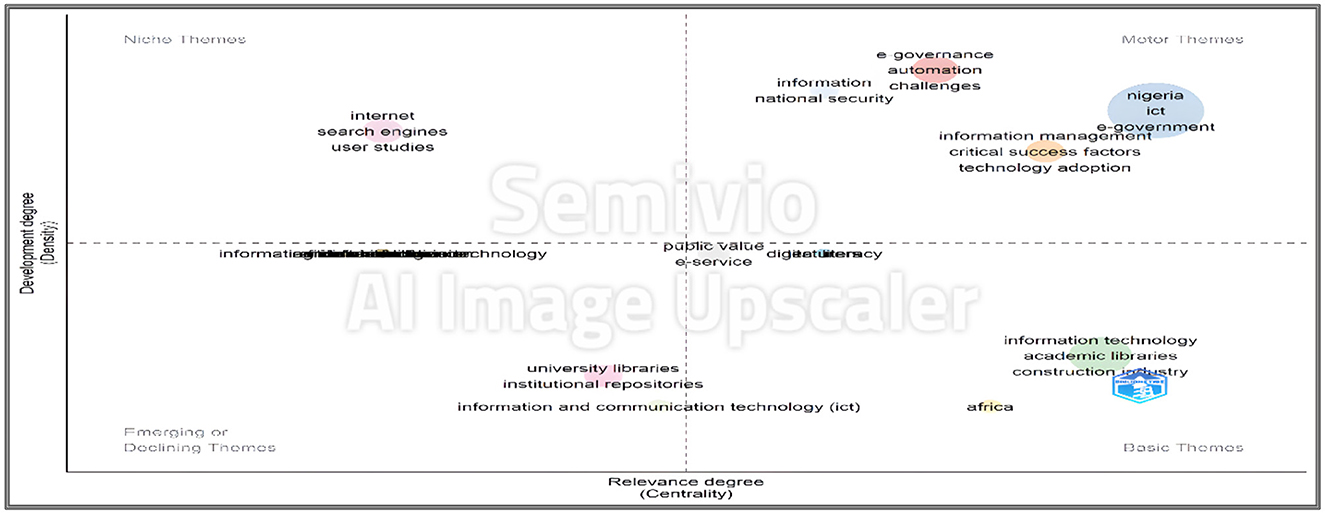
Figure 12. Thematic map. Source: Biblioshiny/Bibliometrix output (Aria and Cuccurullo, 2017).
4.7.1 Motor themes
On the upper-right quadrant of Figure 12 are the motor themes. These themes indicated high centrality and density, which showed that the themes are well-researched and equally significant to the research area (Pandita et al., 2023). In the quadrant were four clusters, with the first having keywords such as “e-governance, automation and challenges,” the second consisted of “information and national security,” the third had “Nigeria, ICT and e-government,” while the fourth included “information management, critical success factors and technology adoption.” In these themes were factors surrounding the deployment of ICT in public administration as noted in the adopted studies, such as the challenges (Abubakar and Adebayo, 2014; Aghimien et al., 2022; Akwang, 2021), success factors, and areas of ICT application.
On the success factors for e-government adoption in Nigeria, Abdulkareem and Ramli (2021) identify information and service quality, while Abdulkareem et al. (2022b) added e-record management as the driver for ICT actual use and user satisfaction. Furthermore, Adekoya et al. (2005), while examining the dynamics of information technology successful implementation in developing countries, a Nigerian case study, identified contextual, technological, and implementation process validities as the predictor variables for a successful information technology adoption in Nigeria (Aghimien et al., 2022). Other e-governance success factors found in the literature were Perceived Usefulness, Perceived Ease of Use, and Computer Self-efficacy (Kabir et al., 2017; Musa et al., 2024; Ogunsola and Tiamiyu, 2021; Olatubosun and Rao, 2012).
Despite the efforts of governments in Sub-Saharan Africa, especially in Nigeria, e-governance initiatives have been largely unsuccessful (Olumoye and Govender, 2018). This failure emanated from the challenges confronting the effective deployment of ICT in governance. Some of these include poor ICT infrastructure (Adeyeye and Iweha, 2005; Baro et al., 2014; Folorunso et al., 2012; Ifinedo, 2006), power failure (Adelowo et al., 2023; Apulu et al., 2011; Asogwa, 2013; Baridam and Govender, 2016; Eze et al., 2013; Iwhiwhu and Eyekpegha, 2009), and data privacy issues (Abubakar and Adebayo, 2014; Akwang, 2021; Awoleye et al., 2014; Oberhiri-Orumah and Baro, 2023). From an extended perspective, Adeyeye and Iweha (2005) added inadequate ICT performance evaluation mechanisms and conflict of interest as to the challenges limiting the effective implementation of ICT in the conduct of governance in Nigeria. More broadly, Aghimien et al. (2022), Dhamodharam and Saminathan (2011), and Eke (2011) classified ICT adoption challenges in developing countries, including Nigeria, as comprising environmental, technological, social, and legal factors.
Also included in the themes were various areas of ICT deployment such as in maintaining national security (Kalu et al., 2020), e-service delivery (Asogwa, 2013; Choudrie et al., 2017; Ibrahim et al., 2016; Ogunsola and Tiamiyu, 2021; Okunola and Rowley, 2019; Tassabehji et al., 2019), and information management (Abdulkareem et al., 2022b; Asogwa et al., 2021; Egoeze et al., 2018; Iwhiwhu, 2005). Concerning Figure 11, e-government with an emphasis on ICT is assuming prominence in these research areas; however, it is currently at the center of public service delivery automation in Nigeria (Abubakar and Adebayo, 2014; Iwhiwhu and Eyekpegha, 2009).
4.7.2 Niche themes
On the other hand, the upper left quadrant, niche themes, comprises keywords such as Internet, search engines, and user studies. These themes had high density but low centrality, indicating that they are well-researched but have limited significance in the research area. Given this understanding, these themes are of little relevance to researchers working on the use of ICT in the Nigerian public administration. Rather, they revolve around the technicalities surrounding public website user interface required for e-government adoption by the citizens (Akporido, 2005; Awalu and Kook, 2019; Folorunso et al., 2012; Oliha, 2023). For instance, Ajani and Agwu (2012) in their study on the use of ICT by small-scale farmers in Anambra State, Nigeria, identified the need for training farmers on the effective use of computers, e-mails, and the Internet for enhancing their activities. Furthermore, Anyira (2013) emphasized the need for proper awareness of the use of search engines by lecturers in the Nigerian private universities.
4.7.3 Emerging or declining themes
These themes, as found on the left lower quadrant of Figure 12, comprise three research clusters with keywords such as “information technology,” “university libraries and institutional repository,” and “information and communication technology (ICT).” This quadrant is characterized by low density and centrality, indicating that research in this study is shifting toward this quadrant. This assertion tallies with the keyword co-occurrence network (overlay) in Figure 10, where ICT, one of the keywords in the emerging/declining themes, is declared to be gaining momentum as a key concept in the use of ICT in the Nigerian public administration, since 2017. Two of these research clusters are, however, close to the basic themes, and this indicates the closeness in the use of these concepts. For instance, the study by Abdulkareem et al. (2022b) connects the emerging/declining and basic themes by investigating the use of ICT for e-record management in Nigeria. This study established low investment in this regard at the Federal Ministry of Finance, Nigeria (FMFN). In addition, the role of ICT adoption in the knowledge sector cannot be overemphasized. For instance, Abidogun (2011) examined the application of information technologies in the pre-primary education institutions in Lagos state. The study found that adequate attention has not been paid to this, despite its potential in developing ICT-compliant citizens necessary for a successful e-government project in Nigeria. Furthermore, Abubakar and Adebayo (2014) explored the use of ICT in the conduct of examinations in Nigeria, using the CBT platform recently deployed by JAMB. The study identified cybersecurity concerns, inadequate ICT infrastructure, and irregular power supply as the major challenges confronting the CBT effort. It thus recommended a crucial investment in ICT infrastructure (Oladipo et al., 2016) and electricity through adequate policy measures.
4.7.4 Basic themes
Finally, the themes in this quadrant have low density but high centrality, indicating the presence of scant literature in the research area despite their importance in discussing the adoption of ICT in the Nigerian public administration. The thematic algorithm carved four research clusters from the themes, and they comprise keywords such as “public value and e-service,” “digital literacy,” “Africa,” and “information technology, academic libraries, and construction industry.” These are topics that require additional research effort given their relevance to the issue addressed in this study. For instance, scant studies exist on the role of openness and social media use in the effective deployment of e-government in Nigeria (Abdulkareem et al., 2022a), as well as in the application of ICT in the Nigerian construction industry (Afieroho et al., 2023; Afolabi et al., 2019; Aghimien et al., 2022; Amade, 2023; Ebekozien et al., 2024, 2023; Oladapo, 2006). Within these themes, the thematic algorithm placed clusters with keywords such as “public value and e-service,” and digital literacy at the center of the map, and bordering the motor themes. These indicated that researchers explore these themes alongside other themes on the map (Inakefe et al., 2023; Pandita et al., 2023). For instance, public value, e-service, and digital literacy are all components of the critical success factor of technology adoption (Abdulkareem et al., 2022a; Abdulkareem and Ramli, 2021; Inakefe et al., 2023; Iwhiwhu and Eyekpegha, 2009; Martens et al., 2020; Okunola et al., 2017).
5 Discussion
In this section, an overview of studies on the use of ICT in the Nigerian public administration is presented. This covers a concise qualitative analysis of the findings and conclusion of adopted studies. Doing this is crucial to identifying prevailing research topics and gaps in the literature. In addition, this aligns with contemporary studies on bibliometric analysis (Agyei et al., 2024; Pandita et al., 2023).
5.1 Major research topics
5.1.1 ICT adoption in public service delivery in Nigeria
The use of digital technology is gaining popularity in the Nigerian governance parlance (Adekoya et al., 2005; Ike et al., 2023). As found in the adopted literature, there exist on Nigeria, abundant literature linking ICT use to promoting public participation (Abdulkareem et al., 2022b; Dasuki et al., 2014; Oni et al., 2020), enhancing employee performance (Ogbonna and Ebimobowei, 2013) through job autonomy and satisfaction (Abdulkareem et al., 2024; Oyovwe-Tinuoye et al., 2021), record management (Abdulkareem et al., 2022b; Egoeze et al., 2018; Muhammad et al., 2020), land, housing, and urban sector administration (Akingbade et al., 2012b; Olumoye and Govender, 2018). In addition, elements of technology integration abound most sectors of the Nigerian economy (Eke, 2011), such as in manufacturing (Buba et al., 2022), financial inclusion (Olaoye and Zerihun, 2023; Siano et al., 2020), entrepreneurship promotion (Gómez et al., 2023; Hassan and Ogundipe, 2017; Obayan, 2022; Okeremi et al., 2021), tax (Okafor, 2012; Omodero et al., 2022), waste (Okafor and Martins, 2017) and electricity management (Dasuki and Abbott, 2015; Dasuki et al., 2014), teaching (Elegbede et al., 2024; Jegede and Owolabi, 2003; Ololube, 2013; Ololube et al., 2013; Onasanya et al., 2010), library resource management (Diyaolu and Oso, 2019; Friday and Eze, 2021; Imam and Ilori, 2023; Iwhiwhu and Eyekpegha, 2009; Iwhiwhu, 2005; Kelvin et al., 2012; Oberhiri-Orumah and Baro, 2023), and agriculture (Fawole and Olajide, 2012; Omekwu, 2003). This indicated a growing commitment to public service transformation in Nigeria. In addition, this established the availability of literature in sufficient quantity and quality on the use of ICT-enabled technology for enhancing public service delivery in the country.
There exist many factors that prompted the use of digital technologies in this regard. As noted by Abdulkareem et al. (2022a), for instance, one of these is the need to establish openness and transparency in government activities (Awalu and Kook, 2019) while encouraging citizens' participation. These facilitate the achievement of good governance, necessary for enhancing public trust in the government and its projects. Another, identified by Abdulkareem et al. (2022b), is the need for proper record management, which can improve information access, warehousing, and retrieval. Despite the abundant literature about ICT use in the Nigerian public administration, achieving an optimum public service delivery standard is still elusive in the country. This indicated that there are challenges confronting ICT initiatives in the country. Aside from the possible hindrances, ICT adoption in governance presents both benefits and threats (Kalu et al., 2020). A concise discussion of these challenges and threats as found in the adopted literature is thus presented below.
5.1.2 E-government implementation challenges in Nigeria
E-government is an ambitious project for developing economies given their ecological context. These contexts have altered the extent of success recorded by the initiative in Nigeria (Olumoye and Govender, 2018; Omohwovo et al., 2021). For instance, inadequate funding (Abdulkareem et al., 2022b; Ajao et al., 2018), ICT-support infrastructure (Adeyeye and Iweha, 2005; Akwang, 2021; Asogwa, 2013; Baridam and Govender, 2016; Baro et al., 2014; Eze et al., 2013; Oberhiri-Orumah and Baro, 2023), and digital divide are the prominent challenges confronting the effective deployment of e-government initiative in Nigeria (Iwhiwhu and Eyekpegha, 2009). More passively, the use of technologies presents threats that require discussion. These threats, as found in the literature, were cybersecurity concerns (Kalu et al., 2020), environmental, technological, social, and legal issues (Abubakar and Adebayo, 2014; Adelowo et al., 2023; Aghimien et al., 2022; Eke, 2011; Ifinedo, 2006; Olumoye and Govender, 2018).
Aside from these issues, Omobowale (2013) noted an emerging e-waste concern in Nigeria. Given the high cost of procuring new technological devices, Nigerians have resorted to second-hand digital technologies that are close to the end of their lifespan. This is evident in the growing markets for London-use ICT gadgets, or Tokunbo, as fondly called in Nigeria. This is rapidly turning Nigeria into a dumping ground for near-end-of-life technologies and further leads to rapid e-waste accumulation in the country, thereby compounding the existing sanitation and environmental challenges in the country. Furthermore, combating the digital divide is also of paramount importance. This can be done through sustainable digital literacy programmes to engender ICT use and user satisfaction (Abdulkareem and Ramli, 2021; Inakefe et al., 2023; Iwhiwhu and Eyekpegha, 2009; Martens et al., 2020; Okunola et al., 2017) among the citizens. Furthermore, improving public record management through the adoption of digital platforms can enhance public sector information management systems in Nigeria (Abdulkareem et al., 2022b; Iwhiwhu, 2005). In addressing the array of challenges found in the literature on the subject, several success factors of ICT integration in governance abound, and they are summarily discussed below.
5.1.3 Success factors of technology adoption in the Nigerian public administration
Implementing an e-governance system successfully required the availability of certain ecological factors. These range from political, social, economic, legal, to infrastructural factors (Aghimien et al., 2022). These, as rebranded by Adekoya et al. (2005), were contextual, technological, and implementation process validities (Adekoya et al., 2005). The combination of these can determine the success of an e-government project (Ajani and Agwu, 2012). Other e-governance success factors found in the literature were Perceived Usefulness, Perceived Ease of Use, and Computer Self-efficacy (Kabir et al., 2017; Musa et al., 2024; Ogunsola and Tiamiyu, 2021; Olatubosun and Rao, 2012). In Nigeria, the availability of these factors, in the right context, has been challenging given the established corruption and bad governance trends in the country (Akingbade et al., 2012a).
Furthermore, literature has established the need for information and service quality as the drivers for ICT use, user satisfaction (Abdulkareem and Ramli, 2021), effective information security measures (Kalu et al., 2020), and public trust building (Amagoh, 2016) in the successful deployment of e-services in Nigeria (Abdulkareem et al., 2022a). In addition, e-record management that leverages social media platforms for information dissemination and mobilizing public participation should be adopted by the Nigerian government (Abdulkareem et al., 2022b). Furthermore, accommodating cultural dimensions with religion and multi-ethnicity context is important to a successful technology adoption initiative in Nigeria (Choudrie et al., 2017; Eke, 2011).
5.2 Research gaps
Despite the abundance of literature on e-government implementation in Nigeria, concerted efforts have not been directed toward several key areas essential for the progressive development of ICT use in governance. These areas, if not thoroughly investigated, can lead to long-term negative effects on the e-government initiatives of the Nigerian government. For instance, there is a dearth of knowledge in areas dealing with how digital governance initiatives impact different demographic groups, particularly teenagers (Abidogun, 2011; Elegbede et al., 2024), rural communities (Balogun et al., 2020; Kari, 2007), elderly citizens, and persons with disabilities. As important components of the Nigerian society, there is a need for this micro-level analysis to enable the government to structure its policy properly. Specifically in Nigeria, the level of digital divide is concerning, and this affects rural communities and the elderly more, thereby cutting them out of the e-government project. Studies in this regard will not only present the peculiar needs of these marginalized groups, it will also project the facilities needed for integrating people with disability in the digital initiative.
In addition, McGrath and Maiye (2010) emphasized the necessity for studies focused on developing indigenous technologies that are compliant with the local context. An emerging argument posits that technology does not just translate to the use of modern digital tools, but rather it encompasses all techniques, whether traditional or modern, that reduce human effort and resources while enhancing performance and output. Over the years, imported technologies have continued to fail in addressing local challenges, either given the inability of the people to relate effectively with these technologies or due to incompatibility in the application of these technologies. For instance, in voting, the Bimodal Voter's Accreditation System (BVAS) introduced in the 2023 general elections in Nigeria could not read the fingerprints of Nigerians in the rural areas as their fingertips have worn out due to their engagement in manual farming systems. Had it been, there are studies done in investigating the peculiar features of local dwellers and the digital electioneering process, a technology compatible with their demographic features would have been developed to seamlessly identify and accredit them during elections. Using this example, there is therefore a need for dedicated research efforts in domesticating e-governance technologies to match the Nigerian context, rather than the current foreign technology-driven approach.
Furthermore, the findings from the thematic analysis of adopted literature showed that the Nigerian e-governance project is yet to integrate artificial intelligence (AI) platforms such as IoT, big data, and digital twin. These technologies present enhanced service delivery opportunities that leverage computer intelligence to personalize citizens' experience efficiently. Aside from cutting government personnel costs, they offer timely and impactful service, and the current Nigerian public administration will immensely benefit from these platforms (Alakitan and Makinde, 2025). In this study, the need for literature in this regard is highly emphasized to bridge the public service gap currently soiling the image of the Nigerian government. Furthermore, researchers need to further explore other ICT adoption success factors aside from public value, e-service, and digital literacy (Abdulkareem et al., 2022a; Inakefe et al., 2023), peculiar to the Nigerian context.
5.3 Recommendations
The recommendations of this study are multifaceted. While some target advancement in knowledge, others focus on improving practice in e-government implementation in Nigeria. First, to advance knowledge, there is a need for further research on the impact of ICT adoption in the Nigerian public administration on vulnerable groups and communities. This can be effectively achieved through a collaborative research network among stakeholders with an interest in advancing the conditions of living of marginalized groups. Doing this could be strategised to incorporate research partnerships among universities, government agencies, and NGOs to conduct empirical studies on technology accessibility and acceptance among elderly citizens, people with disabilities, and teenagers in rural communities. To foster this collaboration, specialized grants for such studies must be funded by either the government or NGOs sharing an interest in the issue.
Furthermore, the application of advanced service-enhancing technologies, such as AI, IoT, and digital twin, requires further investigation in Nigeria. This should be complemented with the development of technologies in the local context and content, possibly in local languages, symbols, and orientations. This can be done through the setting up of innovation labs in each of the geopolitical zones in Nigeria to develop and design technologies suitable for their local communities. Cue could be borrowed from successful indigenous technology adaptations in similar developing economies, such as in South Africa, where indigenous scientists are modernizing indigenous technologies to compete with foreign developed ones. More specifically, efforts in this regard, especially in developing biometric alternatives suitable for agricultural workers and others with worn fingerprints, will significantly promote inclusiveness in subsequent Nigerian elections.
To drive research efforts toward these knowledge gaps, government and academic institutions must fund e-government studies and recognize and reward authors of quality research in this regard. For instance, out of the three most prolific authors of papers adopted in this study, only Aigbavboa from the University of Johannesburg, South Africa, acknowledged funding support from his institution. Others such as Ilori from Obafemi Awolowo University, Ile-Ife, Nigeria, and Abdulkareem from the University of Ilorin, Ilorin, Nigeria, received neither funding, recognition, nor reward from their institutions. This absence of support and recognition is demoralizing for further effort investment on the part of these Nigeria-based scholars.
To practice, this study urges the Nigerian government to review its ICT-related policy and research funding efforts. This could start from strengthening the connection between academic research and policy design and implementation. Academic-government fellowship programs, regular policy dialogue between researchers and government officials, are a few of the approaches that could enhance the performance of e-government initiatives in Nigeria. Effective deployment of e-government platforms leverages a combination of technology, regulations, commitment on the part of the government, and citizens' buy-in. The government must facilitate the interaction of these components. As evidenced in most literature adopted in this study, although investment in the procurement of ICT tools in Nigeria and policy review is growing, what is of serious concern is the fluctuating commitment of successive government administrations. Without consistent government commitment to this project, chances are that the project will continue to record fluctuating performance. For the government to redress this trend, strong political will and leadership are desired in ensuring that digital technology integration targets are met, promised investment in technology is fulfilled, regulation and policy stipulations are adhered to, and mass ICT-literacy campaigns are embarked on to create an educated citizens base necessary for the emerging smart world. This is given the notion of Dhamodharam and Saminathan (2011) that “to be educated is to be able to read, write, and use the computer.”
6 Conclusion
There is an emerging rush toward technology adoption among governments of developing economies. This is given the potential of technological tools in simplifying and enhancing public service delivery. In Nigeria, academics are complementing this effort with insightful research papers; however, the overall quantity and quality of these studies remain uncertain. This study bridged this gap by conducting a bibliometric analysis of existing studies on the use of Information and Communication Technology (ICT) in the Nigerian public administration. Relying on PRISMA inclusion and exclusion criteria, this study examined 128 publications gleaned from the Scopus database using VOSviewer and Biblioshiny as the basic tools of analysis, to provide comprehensive bibliographic features such as the prolific authors, their affiliation, journals, dominant research themes, and research gaps. This study found that authors with the highest research output on the subject were Aigbavboa (Aghimien et al., 2022; Ebekozien et al., 2024, 2023), Ilori (Adelowo et al., 2023; Awoleye et al., 2014; Imam and Ilori, 2023), and Abdulkareem (Abdulkareem et al., 2022a, 2024; Abdulkareem and Ramli, 2021) having affiliations with University of Johannesburg, South Africa; Obafemi Awolowo University, Ile-Ife, Nigeria; and University of Ilorin, Ilorin, Nigeria, respectfully. In addition, journals with an impressive number of publications and citations are Electronic Library, Information Development, and Africa Journal of Science, Technology, Innovation and Development. Furthermore, dominant keywords are Nigeria, ICT, e-government, information technology, developing countries, and policy. Existing studies have centered on e-governance adoption in service delivery, its challenges, and critical success factors. Areas with emerging research interest are the application of information technologies in enhancing institutional libraries and repositories, public value, and e-services. This study concludes that there is a need for future research to explore the impact of digital governance initiatives on demographic groups, particularly children, rural communities, elderly citizens, and persons with disabilities. This is in addition to developing indigenous technologies that comply with local context and blend with emerging components of information and communication technology, such as IoT, big data, and digital twins. To stimulate interest toward the areas deserving of research attention, academic institutions and the government must be willing to train academics and fund research adequately, and this should be done without fear or favor. It is when these values are upheld that genuine and credible research outputs can be recorded. This paper provides a literature review on ICT-public administration research, guides subsequent studies on the subject, and provides policy recommendations for educational institutions and the government on how to support further studies in the research area.
7 Limitations
Despite the comprehensiveness of this study on the use of ICT in the Nigerian public administration, it has its limitations. Specifically, the study only included published journal articles in English from the Scopus database. Consequently, this study omitted studies in other languages and from alternative databases. Furthermore, it excluded non-peer-reviewed documents such as conference papers, books, book chapters, and other significant articles that might enhance the quality and robustness of the analysis. However, this study has contributed to the existing body of knowledge by presenting a comprehensive analysis of Scopus-indexed journal articles on the use of ICT in the Nigerian public administration. The thematic analysis of the adopted papers complemented the quantitative bibliometric analysis to enhance the effectiveness of the review and thus address the limitations mentioned earlier. Major beneficiaries of this study comprise academics, career civil servants, management of academic institutions, and the Nigerian government. While it offers credible information on prominent sources, authors, their affiliations, and research gaps to academics and researchers, it exposes civil servants to multiple cases of ICT application in Nigeria. For the management of higher institutions and the government, it offers effective recommendations on how to motivate researchers toward further studies on the subject, through adequate funding and beneficial policy initiatives.
Data availability statement
Publicly available datasets were analyzed in this study. This data can be found at: Scopus database.
Author contributions
AI: Visualization, Formal analysis, Methodology, Writing – original draft. TM: Writing – review & editing, Supervision, Validation. TG: Resources, Validation, Conceptualization, Writing – review & editing, Supervision.
Funding
The author(s) declare that financial support was received for the research and/or publication of this article. The University of Johannesburg, Johannesburg, South Africa is responsible for the publication cost.
Conflict of interest
The authors declare that the research was conducted in the absence of any commercial or financial relationships that could be construed as a potential conflict of interest.
Generative AI statement
The author(s) declare that no Gen AI was used in the creation of this manuscript.
Publisher's note
All claims expressed in this article are solely those of the authors and do not necessarily represent those of their affiliated organizations, or those of the publisher, the editors and the reviewers. Any product that may be evaluated in this article, or claim that may be made by its manufacturer, is not guaranteed or endorsed by the publisher.
References
Abdulkareem, A. K., Abdulkareem, Z. J., Ishola, A. A., Bello, M. L., and Oladimeji, K. A. (2022a). The influence of openness of public organizations and social media use on e-participation: the mediating effect of trust in e-government. Int. Rev. Public Adm. 27, 281–296. doi: 10.1080/12294659.2022.2136054
Abdulkareem, A. K., Ishola, A. A., Bello, M. L., and Adejumo, A. (2024). The dark side of digitalization: examining the impact of digital overload on job autonomy and job satisfaction. J. Inf. Commun. Ethics Soc. 22, 354–371. doi: 10.1108/JICES-07-2023-0091
Abdulkareem, A. K., and Ramli, R. M. (2021). Does digital literacy predict e-government performance? An extension of Delone and Mclean's information system success model. Electron. Gov. 17, 466–493. doi: 10.1504/EG.2021.118103
Abdulkareem, M. Y., Mnjama, N. M., and Sebina, P. M. I. I. M. (2022b). Training and resources of e-records readiness at the Federal Ministry of Finance in Nigeria. Rec. Manag. J. 32, 43–61. doi: 10.1108/RMJ-06-2019-0028
Abidogun, B. G. (2011). Information and communication technology (ICT) use in teaching and learning at the pre-primary level in Nigeria: the role of the teacher. Int. J. Interdiscip. Soc. Sci. 6, 155–159. doi: 10.18848/1833-1882/CGP/v06i01/51980
Abubakar, A. S., and Adebayo, F. O. (2014). Using computer-based test method for the conduct of examination in Nigeria: prospects, challenges and strategies. Mediterr. J. Soc. Sci. 5, 47–55. doi: 10.5901/mjss.2014.v5n2p47
Adekoya, A. A., Eyob, E., Ikem, F. M., Omojokun, E. O., Quaye, A. M., and Bada, A. O. (2005). Dynamics of Information Technology (IT) successful implementation in development countries: a Nigerian case study. J. Comput. Inf. Syst. 45, 107–112. doi: 10.1080/08874417.2005.11645848
Adeleke, M. A., and Adeleke, A. I. (2024). Differential impact of ICT on MSMEs' productivity in Africa's emerging market. Afr. J. Sci. Technol. Innov. Dev. 16, 40–52. doi: 10.1080/20421338.2023.2247930
Adelowo, A. D., Adelowo, C. M., Binuyo, G. O., and Ilori, M. O. (2023). Innovation types, sources, and challenges in ICT hubs: empirical evidence from Nigeria. Int. J. Technol. Learn. Innov. Dev. 15, 183–206. doi: 10.1504/IJTLID.2023.135342
Aderemi, H. O., Ojediran, I. A., Adegbite, S. A., and Olasanmi, O. O. (2015). Effects of the use of ICT on pharmaceutical product marketing in Nigeria. Int. J. Manag. Bus. Res. 5, 315–327.
Aderibigbe, N. A., and Ajiboye, B. A. (2013). User education program as determinant of electronic information resources usage in Nimbe Adedipe University Library, Nigeria. Electron. Libr. 31, 244–255. doi: 10.1108/02640471311312410
Adeyeye, M., and Iweha, C. C. (2005). Towards an effective national policy on information and communication technologies for Nigeria. Inf. Dev. 21, 202–208. doi: 10.1177/0266666905057337
Adomi, E. E., Obarakpor, E. F., and Akparobore, D. O. (2005). The use of information technology (IT) by electronic media workers in Delta State, Nigeria. Electron. Libr. 23, 295–301. doi: 10.1108/02640470510603697
Afieroho, P., Perkins, R., Zhou, X. T., Hoanca, B., and Protasel, G. (2023). Adopting e-government to monitor public infrastructure projects execution in Nigeria: the public perspective. Heliyon 9:e18552. doi: 10.1016/j.heliyon.2023.e18552
Afolabi, A., Ibem, E., Aduwo, E., Tunji-Olayeni, P., and Oluwunmi, O. (2019). Critical success factors (CSFs) for e-procurement adoption in the Nigerian construction industry. Buildings 9:47. doi: 10.3390/buildings9020047
Aghimien, D. O., Aigbavboa, C., Edwards, D. J., Mahamadu, A. M., Olomolaiye, P., Nash, H., et al. (2022). A fuzzy synthetic evaluation of the challenges of smart city development in developing countries. Smart Sustain. Built Environ. 11, 405–421. doi: 10.1108/SASBE-06-2020-0092
Agunloye, O. (2007). “An overview of the implementation of the e-government program in Nigeria,” in Proceedings of the 1st International Conference on Theory and Practice of Electronic Governance (ICEGOV '07), Macao, China (New York, NY: Association for Computing Machinery), 2. doi: 10.1145/1328057.1328060
Agyei, V., Adom-Asamoah, G., and Poku-Boansi, M. (2024). Sustainable transportation in Africa: a bibliometric, visualisation and thematic analysis. J. Clean. Prod. 462:142727. doi: 10.1016/j.jclepro.2024.142727
Ajani, E. N., and Agwu, A. E. (2012). Information communication technology needs of small-scale farmers in Anambra State, Nigeria. J. Agric. Food Inf. 13, 144–156. doi: 10.1080/10496505.2012.663694
Ajao, B. F., Oyebisi, T. O., and Aderemi, H. O. (2018). Factors influencing the implementation of e-commerce innovations: the case of the Nigerian informal sector. Afr. J. Sci. Technol. Innov. Dev. 10, 473–481. doi: 10.1080/20421338.2018.1475541
Akingbade, A., Navarra, D., Zevenbergen, J., and Georgiadou, Y. (2012b). The impact of electronic land administration on urban housing development: the case study of the federal capital territory of Nigeria. Habitat Int. 36, 324–332. doi: 10.1016/j.habitatint.2011.10.008
Akingbade, A. O., Navarra, D. D., Georgiadou, Y., and Zevenbergen, J. A. (2012a). A case study of geo-ICT for e-government in Nigeria: does computerisation reduce corruption in the provision of land administration services? Surv. Rev. 44, 290–300. doi: 10.1179/1752270611Y.0000000023
Akporido, C. E. (2005). Internet use in a Nigerian suburban setting. Electron. Libr. 23, 302–310. doi: 10.1108/02640470510603705
Akwang, N. E. (2021). A study of librarians' perceptions and adoption of Web 2.0 technologies in academic libraries in Akwa Ibom State, Nigeria. J. Acad. Librariansh. 47:102299. doi: 10.1016/j.acalib.2020.102299
Alakitan, M., and Makinde, E. (2025). Where are the ethical guidelines? Examining the governance of digital technologies and AI in Nigeria. Policy Internet. 17, 1–18. doi: 10.1002/poi3.416
Albugami, H. F., Kaikubad Ali, M., Hossain, S., Zaffar, H., and Ahmad, N. (2024). Climate change and sustainable livelihood in South Asia: a bibliometric analysis. Environ. Sustain. Indic. 24:100524. doi: 10.1016/j.indic.2024.100524
Amade, B. (2023). Exploring the influence of information and communication technology (ICT) on construction supply chain management: Empirical evidence from a construction project's perspective. J. Project Manag. 8, 67–80. doi: 10.5267/j.jpm.2022.7.001
Amagoh, F. (2016). Determinants of e-government diffusion in Nigeria: an examination of theoretical models. Inf. Dev. 32, 1137–1154. doi: 10.1177/0266666915593330
Anemelu, V. C., and Nwokolo, C. (2016). Assessment of institutional provision of ICT for effective learning in institutions: a study of ICT development in Nnamdi Azikiwe University, Awka, Nigeria. J. Soc. Sci. Res. 2, 147–151.
Ani, O. E., Ngulube, P., and Onyancha, B. (2015). Perceived effect of accessibility and utilization of electronic resources on productivity of academic staff in selected Nigerian universities. SAGE Open 5, 1–7. doi: 10.1177/2158244015607582
Anyira, I. E. (2013). Gender implications in awareness and use of search engines by private university lecturers in South-South, Nigeria. Lib. Philos. Pract. 2013:1039.
Apulu, I., Latham, A., and Moreton, R. (2011). Factors affecting the effective utilisation and adoption of sophisticated ICT solutions: Case studies of SMEs in Lagos, Nigeria. J. Syst. Inf. Technol. 13, 125–143. doi: 10.1108/13287261111135972
Aria, M., and Cuccurullo, C. (2017). Bibliometrix: an R-tool for comprehensive science mapping analysis. J. Informetr. 11, 959–975. doi: 10.1016/j.joi.2017.08.007
Asogwa, B., Ali, A., Onoh, C., Asogwa, M., Ngwuchukwu, M., Igbokwe, J., et al. (2021). Preparedness of Nigerian University libraries for the acquisition and management of digital records. Libri 71, 335–348. doi: 10.1515/libri-2019-0093
Asogwa, B. E. (2013). Electronic government as a paradigm shift for efficient public services: Opportunities and challenges for Nigerian government. Library Hi Tech 31, 141–159. doi: 10.1108/07378831311303985
Augustine, A. A. (2021). Availability and utilization of information and communication technology (ICT) facilities for services in Nigeria French language village library. Lib. Philos. Pract. 2021, 1–20.
Awalu, I. L., and Kook, P. H. (2019). A quantitative evaluation of website transparency. Test Eng. Manag. 81, 125–136.
Awoleye, O. M. (2022). Knowledge spillover, human capital, and agglomeration dynamics in Nigeria's ICT clusters. Int. J. Bus. Innov. Res. 27, 352–382. doi: 10.1504/IJBIR.2022.121695
Awoleye, O. M., Ojuloge, B., and Ilori, M. O. (2014). Web application vulnerability assessment and policy direction towards a secure smart government. Gov. Inf. Q. 31, S118–S125. doi: 10.1016/j.giq.2014.01.012
Ayanlade, O. S., Oyebisi, T. O., and Kolawole, B. A. (2018). Development of an ICT-based framework towards sustainable optimal diabetes management in the Nigerian health sector. Informatics Med. Unlock. 11, 36–43. doi: 10.1016/j.imu.2018.04.002
Badamas, M. A. (2009). Information, knowledge, and technology management: national information technology policies for sustainable development. Int. J. Technol. Manag. 45, 156–176. doi: 10.1504/IJTM.2009.021526
Balogun, N. A., Ehikhamenor, F. A., Mejabi, O. V., Oyekunle, R. A., Bello, O. W., and Afolayan, O. T. (2020). Exploring information and communication technology among rural dwellers in sub-Saharan African communities. Afr. J. Sci. Technol. Innov. Dev. 12, 533–545. doi: 10.1080/20421338.2019.1700668
Baridam, B. B., and Govender, I. (2016). The role of information and communication policies in the governance of the healthcare sector. Risk Govern. Control: Financ. Markets Inst. 6, 31–35. doi: 10.22495/rcgv6i3art5
Baro, E. E., Godfrey, V. Z., and Eze, M. E. (2014). Electronic theses and dissertations initiatives: a survey of university libraries in Nigeria. Int. Inf. Libr. Rev. 46, 41–50. doi: 10.1080/10572317.2014.936265
Buba, A. K., Ibrahim, O., and Shehzad, H. M. F. (2022). Behavioral intention model for green information technology adoption in Nigerian manufacturing industries. Aslib J. Inf. Manag. 74, 158–180. doi: 10.1108/AJIM-05-2021-0128
Choudrie, J., Zamani, E. D., Umeoji, E., and Emmanuel, A. (2017). Implementing E-government in Lagos State: Understanding the impact of cultural perceptions and working practices. Gov. Inf. Q. 34, 646–657. doi: 10.1016/j.giq.2017.11.004
Dasuki, S. I., and Abbott, P. (2015). A socio-technical analysis of ICT investments in developing countries: a capability perspective. Electron. J. Inf. Syst. Dev. Ctries. 67, 1–29. doi: 10.1002/j.1681-4835.2015.tb00484.x
Dasuki, S. I., Abbott, P., and Azerikatoa, D. (2014). ICT and empowerment to participate: a capability approach. Inf. Dev. 30, 321–331. doi: 10.1177/0266666913485259
Dhamodharam, R., and Saminathan, A. (2011). “Challenges of e-government in African countries: Creating an enabling environment in Nigeria,” in: 2011 IST-Africa Conference Proceedings, IST 2011. Available online at: https://www.scopus.com/inward/record.uri?eid=2-s2.0-84855789613andpartnerID=40andmd5=2641448ba1a577f8297955ecabe64ac4
Diyaolu, A. M., and Oso, O. O. (2019). Challenges of integrated library system (ILS) migration in selected academic libraries in Oyo State, Nigeria. Lib. Philos. Pract. 2019:2535. Availanle online at: https://www.scopus.com/inward/record.uri?eid=2-s2.0-85066069802andpartnerID=40andmd5=3b35fefb713a650062a8c2bed87101d6
Ebekozien, A., Aigbavboa, C., Emuchay, F. E., Aigbedion, M., Ogbaini, I. F., and Awo-Osagie, A. I. (2024). Urban solid waste challenges and opportunities to promote sustainable developing cities through the fourth industrial revolution technologies. Int. J. Build. Pathol. Adapt. 42, 729–750. doi: 10.1108/IJBPA-09-2021-0119
Ebekozien, A., Aigbavboa, C., and Samsurijan, M. S. (2023). An appraisal of blockchain technology relevance in the 21st-century Nigerian construction industry: perspective from the built environment professionals. J. Global Oper. Strateg. Sourc. 16, 142–160. doi: 10.1108/JGOSS-01-2022-0005
Egoeze, F., Misra, S., Maskeliunas, R., and Damaševičius, R. (2018). Impact of ICT on universities' administrative services and management of students' records: ICT in university administration. Int. J. Hum. Capital Inf. Technol. Prof. 9, 1–15. doi: 10.4018/IJHCITP.2018040101
Eke, D. O. (2011). ICT integration in Nigeria: the socio-cultural constraints. Int. J. Technol. Hum. Interact. 7, 21–27. doi: 10.4018/jthi.2011040103
Elegbede, C. B., Adedotun, K. O., Lapite, A. O., Idhalama, O. U., and Aluede, O. (2024). Exploring the use of technology in improving access to education for internally displaced children in Nigeria: a review. Inf. Dev. 1–15. doi: 10.1177/02666669241268228
Eze, S. C., Awa, H. O., Okoye, J. C., Emecheta, B. C., and Anazodo, R. O. (2013). Determinant factors of information communication technology (ICT) adoption by government-owned universities in Nigeria: a qualitative approach. J. Enterp. Inf. Manag. 26, 427–443. doi: 10.1108/JEIM-05-2013-0024
Fawole, O. P., and Olajide, B. R. (2012). Awareness and use of information communication technologies by farmers in Oyo State, Nigeria. J. Agric. Food Inf. 13, 326–337. doi: 10.1080/10496505.2012.717003
Folorunso, O., Chen, C., Ahmed, N., and Harris, T. (2012). Towards active citizen-centric e-government systems for developing countries. Int. J. E-Adopt. 4, 52–64. doi: 10.4018/jea.2012040104
Friday, J. E., and Eze, M. E. (2021). Digital preservation of electronic theses and dissertations in public university libraries in South-East Nigeria. Lib. Philos. Pract. 2021, 1–22.
Gómez, G. M., Manya, V., and Fransen, J. (2023). Vital entrepreneurial ecosystems: the case of ICT in Yaba, Nigeria. Cities 137:104289. doi: 10.1016/j.cities.2023.104289
Gyebo, A. V. S., Ahamat, A., and Yahaya, S. N. (2022). A review on information communication technology adoption in the Nigerian healthcare sector. Int. J. Electron. Healthc. 12, 279–298. doi: 10.1504/IJEH.2022.124488
Hassan, A. O., Ishola, A. A., and Lamidi, K. O. (2024). Transforming election management through information and communication technology: the Nigerian experience. African Renaissance 2024, 135–167.
Hassan, H., and Ogundipe, A. A. (2017). ICT adoption by micro and small-scale enterprises in Nigeria: A case study of the Federal Capital Territory, Abuja. Int. J. Econ. Res. 14, 117–137.
Hassan, O. M., Siyanbola, W. O., and Oyebisi, T. O. (2011). An evaluation of the implementation mechanisms of Nigeria's information technology policy. Int. J. Technol. Policy Manag. 11, 57–67. doi: 10.1504/IJTPM.2011.040301
He, T., Yang, S., Zhu, C., Zhang, B., Zhang, Q., Ji, Y., et al. (2025). A bibliometric analysis of research on empathy for pain. Neuropharmacology 262:110193. doi: 10.1016/j.neuropharm.2024.110193
Ibrahim, R., Hilles, S. M. S., Adam, S. M., Jamous, M. M., and Yafooz, W. M. S. (2016). Theoretical framework formation for e-government services evaluation: case study of federal republic of Nigeria. Indian J. Sci. Technol. 9:94575. doi: 10.17485/ijst/2016/v9i37/94575
Ifinedo, P. (2006). Towards e-government in a Sub-Saharan African Country: impediments and initiatives in Nigeria. J. E-Gov. 3, 3–28. doi: 10.1300/J399v03n01_02
Ike, G. U., Inakefe, G. I., and Bassey, V. U. (2023). Integrated personnel and payroll information system and public financial management in Nigeria's public service. Afr. Renaissance 20, 53–84.
Ikwu, A. N., Komolafe, D. T., Ahaneku, G. I., and Nwawudu, S. E. (2021). Advancement of telemedicine in Africa and the current laws: a case study of Nigeria. Medico-Legal J. 89, 270–275. doi: 10.1177/00258172211018341
Imam, A., and Ilori, M. E. (2023). Library services and information management: the role of academic librarians in the 21st century Nigeria. Internet Refer. Serv. Q. 27, 103–109. doi: 10.1080/10875301.2023.2172637
Inakefe, G. I., Bassey, V. U., Ikeanyibe, O. M., Nwagboso, C. I., Agbor, U. I., Ebegbulem, J., et al. (2023). Digital literacy and e-governance adoption for service delivery in cross river state civil service. Int. J. Electron. Gov. Res. 19, 1–23. doi: 10.4018/IJEGR.328327
Iwhiwhu, B. E., and Eyekpegha, E. O. (2009). Digitization of Nigerian university libraries: from technology challenge to effective information delivery. Electron. Libr. 27, 529–536. doi: 10.1108/02640470910966943
Iwhiwhu, E. B. (2005). Management of records in Nigerian universities: problems and prospects. Electron. Libr. 23, 345–355. doi: 10.1108/02640470510603741
Jegede, P. O., and Owolabi, J. A. (2003). Computer education in Nigerian secondary schools: Gaps between policy and practice. Meridian 6, 1–11.
Kabir, M. A., Saidin, S. Z., and Ahmi, A. (2017). An examination of factors that influence employees' behavioral intention to use the electronic revenue collection system in public hospitals. J. Telecommun. Electron. Comput. Eng. 9, 109–114. Available online at: https://jtec.utem.edu.my/jtec/article/view/2747
Kalaoane, R. C., Musakwa, W., Kibangou, A., Gumbo, T., Musonda, I., and Matamanda, A. R. (2024). Bibliometric analysis of quality of service in public transportation: current and future trends. Sci. Afr. 23:e02059. doi: 10.1016/j.sciaf.2024.e02059
Kalia, V., and Rajput, P. (2024). Research trends in dry needling for neck pain treatment: a bibliometric analysis. J. Chiropr. Humanit. 31, 33–47. doi: 10.1016/j.echu.2024.02.002
Kalu, C. O., Chidi-Kalu, E. I., Okidi, I. A. A., and Usiedo, B. A. (2020). Issues on information systems, ICTs, cyber-crimes, cyber security, cyber ethics, and national security in Nigeria: librarians' research. Lib. Philos. Pract. 2020, 1–20.
Kari, H. K. (2007). Availability and accessibility of ICT in the rural communities of Nigeria. Electron. Libr. 25, 363–372. doi: 10.1108/02640470710754869
Kelvin, O. O., Oghenetega, I., and Jackson, A. (2012). A review of issues in information and communication technology (ICT) planning and implementation in academic libraries in Nigeria. Libr. Hi Tech News 29, 11–17. doi: 10.1108/07419051211287624
Lawan, A. M., Ramli, R. M., and Razali, S. Z. (2019). Analyzing the impact of information and communication technology (ICT) on the restructuring of public service in Nigeria. Int. J. Recent Technol. Eng. 8, 709–711. doi: 10.35940/ijrte.B1147.0982S919
Li, D., Wang, H., Li, Y., Cao, Y., Wu, K., and Wang, Q. (2024). Current trends and hotspots of etiology of auditory neuropathy in the past 30 years: a bibliometric analysis. J. Otol. 19, 113–119. doi: 10.1016/j.joto.2024.07.003
Martens, M., Hajibayova, L., Campana, K., Rinnert, G. C., Caniglia, J., Bakori, I. G., et al. (2020). “Being on the wrong side of the digital divide”: seeking technological interventions for education in Northeast Nigeria. Aslib J. Inf. Manag. 72, 963–978. doi: 10.1108/AJIM-05-2020-0172
McGrath, K., and Maiye, A. (2010). The role of institutions in ICT innovation: learning from interventions in a Nigerian e-government initiative. Inf. Technol. Dev. 16, 260–278. doi: 10.1080/02681102.2010.498408
Mufungizi, A. A., Musakwa, W., and Chanza, N. (2023). Shifting ecosystems, past, current, and emerging trends: a bibliometric analysis and systematic review of literature. Ecol. Indic. 156:111175. doi: 10.1016/j.ecolind.2023.111175
Muhammad, A. S., and Kaya, T. (2023). Factors affecting the citizens' intention to adopt e-government in Nigeria. J. Inf. Commun. Ethics Soc. 21, 271–289. doi: 10.1108/JICES-05-2022-0054
Muhammad, J. S., Isa, A. M., Samsudin, A. Z. H., and Miah, S. J. (2020). Critical factors for implementing effective information governance in Nigerian universities: a case study investigation. Educ. Inform. Technol. 25, 5565–5580. doi: 10.1007/s10639-020-10206-3
Musa, U., Jaafar, M., and Raslim, F. M. (2024). E-procurement adoption in Nigeria: perceptions from the public sector employees. Arab Gulf J. Sci. Res. 42, 1130–1149. doi: 10.1108/AGJSR-10-2022-0224
Muzioreva, H., Gumbo, T., Kavishe, N., Moyo, T., and Musonda, I. (2022). Decentralized wastewater system practices in developing countries: a systematic review. Util. Policy 79:101442. doi: 10.1016/j.jup.2022.101442
Obasola, O. I., and Mabawonku, I. M. (2017). Women's use of information and communication technology in accessing maternal and child health information in Nigeria. Afr. J. Libr. Arch. Inf. Sci. 27, 1–15.
Obayan, K. (2022). Entrepreneurial hustle and the rise (and fall) of personal computer companies in Lagos, Nigeria: 1960–1999. IEEE Ann. Hist. Comput. 44, 6–16. doi: 10.1109/MAHC.2022.3182631
Oberhiri-Orumah, G., and Baro, E. E. (2023). The extent of building and managing local contents in institutional repositories: a survey of tertiary institution libraries in Nigeria. Glob. Knowl. Mem. Commun. 72, 464–483. doi: 10.1108/GKMC-08-2021-0139
Ogbonna, G. N., and Ebimobowei, A. (2013). Information technology and the performance of accountants in the Nigerian oil and gas industry. Res. J. Appl. Sci. Eng. Technol. 6, 202–212. doi: 10.19026/rjaset.6.4059
Ogunsola, K., and Tiamiyu, M. (2021). Predicting customers' use of electronic government services in Nigeria. Int. J. Public Adm. Digital Age 8:oa4. doi: 10.4018/IJPADA.20210101.oa4
Okafor, A. O., and Martins, J. T. (2017). Institutional stakeholder perceptions of barriers to Green IT policy in Nigeria. Int. J. Technol. Manag. Sustain. Dev. 16, 71–95. doi: 10.1386/tmsd.16.1.71_1
Okafor, G. T. (2012). Revenue generation in Nigeria through e-taxation (a study of selected states). Eur. J. Econ. Finance Admin. Sci. 126–132.
Okeremi, A., Amoako-Gyampah, K., and Divine Caesar, L. (2021). Exploring the antecedents of entrepreneurship success in information technology firms in Nigeria. Africa Journal of Management 7, 286–313. doi: 10.1080/23322373.2021.1902210
Okunola, O. M., and Rowley, J. (2019). User experience of e-government: the Nigeria immigration service. Library Hi Tech 37, 355–373. doi: 10.1108/LHT-09-2018-0138
Okunola, O. M., Rowley, J., and Johnson, F. (2017). The multi-dimensional digital divide: Perspectives from an e-government portal in Nigeria. Gov. Inf. Q. 34, 329–339. doi: 10.1016/j.giq.2017.02.002
Oladapo, A. A. (2006). The impact of ICT on professional practice in the Nigerian construction industry. Electron. J. Inf. Syst. Dev. Ctries. 24, 1–19. doi: 10.1002/j.1681-4835.2006.tb00157.x
Oladipo, O., Murphy, A., Anannsingh-Jamieson, F., and Amaghionyeodiwe, L. (2016). Information and communication technology, and economic growth in Nigeria: a time series analysis. Int. J. Technol. Policy Manag. 16, 149–162. doi: 10.1504/IJTPM.2016.076315
Olaoye, O., and Zerihun, M. F. (2023). Financial inclusion and poverty reduction in Nigeria: the role of information and communication technology (ICT). Afr. J. Econ. Manag. Stud. 14, 726–740. doi: 10.1108/AJEMS-12-2022-0488
Olatubosun, O., and Rao, K. S. M. (2012). Empirical study of the readiness of public servants on the adoption of e-government. Int. J. Inf. Syst. Change Manag. 6, 17–37. doi: 10.1504/IJISCM.2012.050337
Oliha, F. O. (2023). An automated tool-based performability assessment of selected e-Government websites in Nigeria. Int. J. Electron. Govern. 15, 151–168. doi: 10.1504/IJEG.2023.132350
Ololube, N. P. (2013). Evaluating the usage and integration of ITs and ISs in teacher education programs in a sprouting nation. Medit. J. Soc. Sci. 4, 63–72. doi: 10.5901/mjss.2013.v4n16p63
Ololube, N. P., Kpolovie, P. J., Amaele, S., Amanchukwu, R. N., and Briggs, T. (2013). Digital natives and digital immigrants: A study of information technology and information systems (IT/IS) usage between students and faculty of Nigerian Universities. Int. J. Inf. Commun. Technol. Educ. 9, 42–64. doi: 10.4018/jicte.2013070104
Olumoye, M. Y., and Govender, I. (2018). An empirical investigation of factors influencing integrated e-Government implementation in Nigeria: a case of housing and urban development agency. Electron. J. Inf. Syst. Dev. Ctries. 84:e12012. doi: 10.1002/isd2.12012
Omekwu, C. O. (2003). National agricultural information management system in Nigeria: a conceptual framework. Lib. Rev. 52, 444–451. doi: 10.1108/00242530310501464
Omobowale, A. O. (2013). Tokunbo ICT: symbolic-rationality of second-hand ICT utilization in Nigeria. Int. J. Sociol. Soc. Policy 33, 509–523. doi: 10.1108/IJSSP-05-2012-0042
Omodero, C. O., Ujah, P. I., and Iyoha, F. O. (2022). Foreign direct investment and information communication technology taxation effects on tax income growth. Revue d'Intelligence Artificielle 36, 387–393. doi: 10.18280/ria.360306
Omohwovo, O. E., Olatokun, W. M., Ojutawo, I. R., and Okocha, J. O. (2021). Information and communication technology projects and management information system in Nigerian universities: a design reality approach. Lib. Philos. Pract. 2021, 1–18.
Onasanya, S. A., Shehu, R. A., Oduwaiye, R. O., and Shehu, L. A. (2010). Higher institutions lecturers' attitude towards integration of ICT into teaching and research in Nigeria. Res. J. Inf. Technol. 2, 1–10. doi: 10.3923/rjit.2010.1.10
Oni, S., Oni, A. A., Ibietan, J., and Deinde-Adedeji, G. O. (2020). E-consultation and the quest for inclusive governance in Nigeria. Cogent Soc. Sci. 6:1823601. doi: 10.1080/23311886.2020.1823601
Oyovwe-Tinuoye, G. O., Omeluzor, S. U., and Patrick, I. O. (2021). Influence of ICT skills on job performance of librarians in university libraries of South-South, Nigeria. Inf. Dev. 37, 345–358. doi: 10.1177/0266666920983393
Ozen Cinar, I. (2024). General, social, and intellectual structure of breastfeeding studies in the field of nursing: a bibliometric analysis on R software. J. Pediatr. Nurs. 80, e24–e33. doi: 10.1016/j.pedn.2024.10.036
Pandita, S., Mishra, H. G., Bhat, A. A., Mishra, R. K., and Singh, R. (2023). The sharing economy: an integrated systematic review using TCCM and bibliometric analysis. Vision 29:9722629221142714. doi: 10.1177/09722629221142714
Sanni, S. A., Ilori, M. O., Opaleye, A. O., and Oyewale, A. A. (2001). Nigeria's technology policy: is it adequate in the globalizing world? Technovation 21, 237–243. doi: 10.1016/S0166-4972(00)00044-4
Siano, A., Raimi, L., Palazzo, M., and Panait, M. C. (2020). Mobile banking: an innovative solution for increasing financial inclusion in sub-Saharan African countries: evidence from Nigeria. Sustainability 12:10130. doi: 10.3390/su122310130
Tassabehji, R., Hackney, R., and Maruyama, T. (2019). Evaluating digital public services: a contingency value approach within three exemplar developing countries. Inf. Technol. People 32, 1021–1043. doi: 10.1108/ITP-08-2017-0260
Uzodike, U. O., and Onapajo, H. (2019). Beyond the card reader: anti-election rigging technology and national security in Nigeria. Insight Afr. 11, 145–161. doi: 10.1177/0975087819845194
Van Eck, N. J., and Waltman, L. (2023). VOSviewer Manual [VOSmanual]. Manual version 1.6.19, 1–55. Available online at: https://www.vosviewer.com/documentation/Manual_VOSviewer_1.6.19.pdf
Keywords: e-governance, bibliometric analysis, ICT, public administration, Scopus, Nigeria
Citation: Ishola AA, Maramura TC and Gumbo T (2025) Charting digital governance: a bibliometric analysis of information and communication technology research in Nigeria's public administration using Scopus. Front. Sustain. Cities 7:1605736. doi: 10.3389/frsc.2025.1605736
Received: 03 April 2025; Accepted: 19 May 2025;
Published: 09 June 2025.
Edited by:
Thomas Ramsey, China Three Gorges University, ChinaReviewed by:
Michael Black, Consultant, Kaohsiung, TaiwanBuck Ryan, University of Kentucky, United States
Yang Yang, China Three Gorges University, China
Copyright © 2025 Ishola, Maramura and Gumbo. This is an open-access article distributed under the terms of the Creative Commons Attribution License (CC BY). The use, distribution or reproduction in other forums is permitted, provided the original author(s) and the copyright owner(s) are credited and that the original publication in this journal is cited, in accordance with accepted academic practice. No use, distribution or reproduction is permitted which does not comply with these terms.
*Correspondence: Abdulrasaq Ajadi Ishola, YWlzaG9sYUB1ai5hYy56YQ==
 Abdulrasaq Ajadi Ishola
Abdulrasaq Ajadi Ishola Tafadzwa Clementine Maramura
Tafadzwa Clementine Maramura Trynos Gumbo
Trynos Gumbo
